Logistics and Supply Chain Management
VerifiedAdded on 2023/06/03
|37
|10191
|458
AI Summary
This dissertation focuses on the impact of global logistics on operating costs of ATLAS Logistics in the UK. It explores logistics models and strategies, evaluates the impact of operating costs while implementing mixed transportation models, and provides recommendations for improvement.
Contribute Materials
Your contribution can guide someone’s learning journey. Share your
documents today.
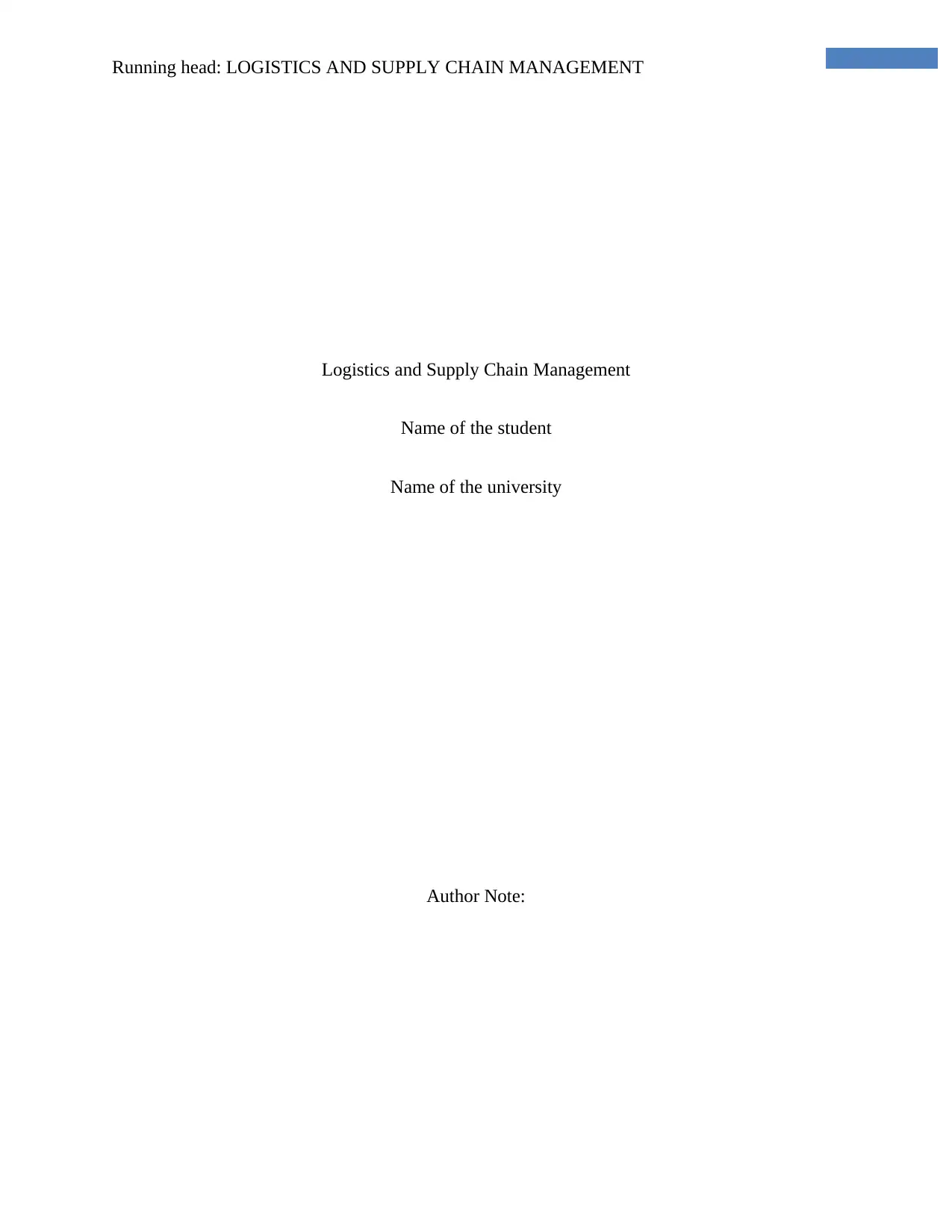
Running head: LOGISTICS AND SUPPLY CHAIN MANAGEMENT
Logistics and Supply Chain Management
Name of the student
Name of the university
Author Note:
Logistics and Supply Chain Management
Name of the student
Name of the university
Author Note:
Secure Best Marks with AI Grader
Need help grading? Try our AI Grader for instant feedback on your assignments.
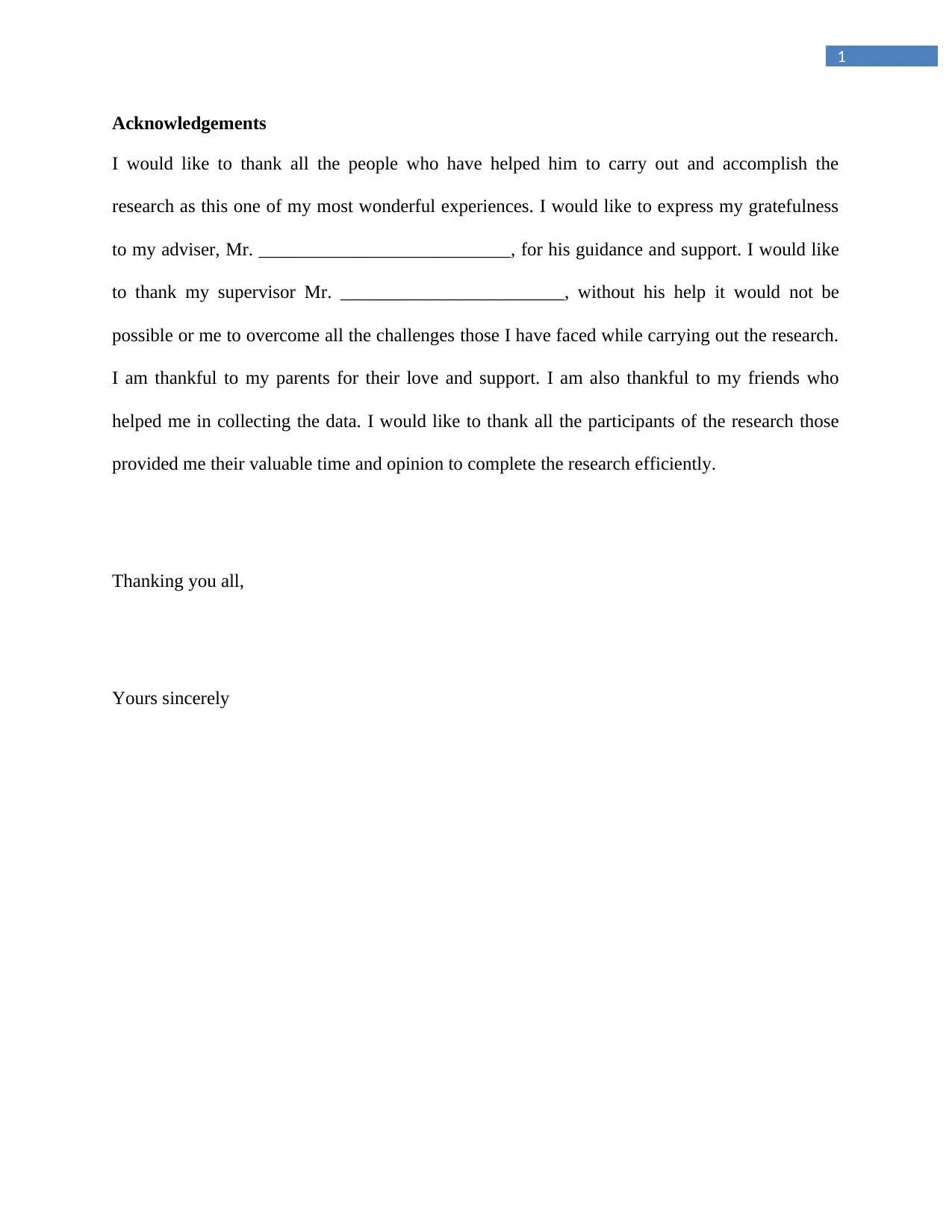
1
Acknowledgements
I would like to thank all the people who have helped him to carry out and accomplish the
research as this one of my most wonderful experiences. I would like to express my gratefulness
to my adviser, Mr. ___________________________, for his guidance and support. I would like
to thank my supervisor Mr. ________________________, without his help it would not be
possible or me to overcome all the challenges those I have faced while carrying out the research.
I am thankful to my parents for their love and support. I am also thankful to my friends who
helped me in collecting the data. I would like to thank all the participants of the research those
provided me their valuable time and opinion to complete the research efficiently.
Thanking you all,
Yours sincerely
Acknowledgements
I would like to thank all the people who have helped him to carry out and accomplish the
research as this one of my most wonderful experiences. I would like to express my gratefulness
to my adviser, Mr. ___________________________, for his guidance and support. I would like
to thank my supervisor Mr. ________________________, without his help it would not be
possible or me to overcome all the challenges those I have faced while carrying out the research.
I am thankful to my parents for their love and support. I am also thankful to my friends who
helped me in collecting the data. I would like to thank all the participants of the research those
provided me their valuable time and opinion to complete the research efficiently.
Thanking you all,
Yours sincerely

2
Table of Contents
1. Introduction..................................................................................................................................5
1.1 Purpose...................................................................................................................................5
1.2 Background of the research....................................................................................................5
1.3 Background of the company..................................................................................................6
1.4 Thesis statement.....................................................................................................................6
1.5 Definitions..............................................................................................................................6
1.6 Overview................................................................................................................................7
1.7 Research Objective................................................................................................................8
1.8 Research Questions................................................................................................................8
1.9 Structure of the dissertation...................................................................................................8
2. Literature Review........................................................................................................................9
2.1 Introduction............................................................................................................................9
2.2 Concept of logistics................................................................................................................9
2.3 Logistics Efficiency.............................................................................................................11
2.4 Transportation Models in Logistics.....................................................................................11
2.5 Differentiation of Logistics..................................................................................................12
2.6 Strategy vs. Process..............................................................................................................13
Table of Contents
1. Introduction..................................................................................................................................5
1.1 Purpose...................................................................................................................................5
1.2 Background of the research....................................................................................................5
1.3 Background of the company..................................................................................................6
1.4 Thesis statement.....................................................................................................................6
1.5 Definitions..............................................................................................................................6
1.6 Overview................................................................................................................................7
1.7 Research Objective................................................................................................................8
1.8 Research Questions................................................................................................................8
1.9 Structure of the dissertation...................................................................................................8
2. Literature Review........................................................................................................................9
2.1 Introduction............................................................................................................................9
2.2 Concept of logistics................................................................................................................9
2.3 Logistics Efficiency.............................................................................................................11
2.4 Transportation Models in Logistics.....................................................................................11
2.5 Differentiation of Logistics..................................................................................................12
2.6 Strategy vs. Process..............................................................................................................13
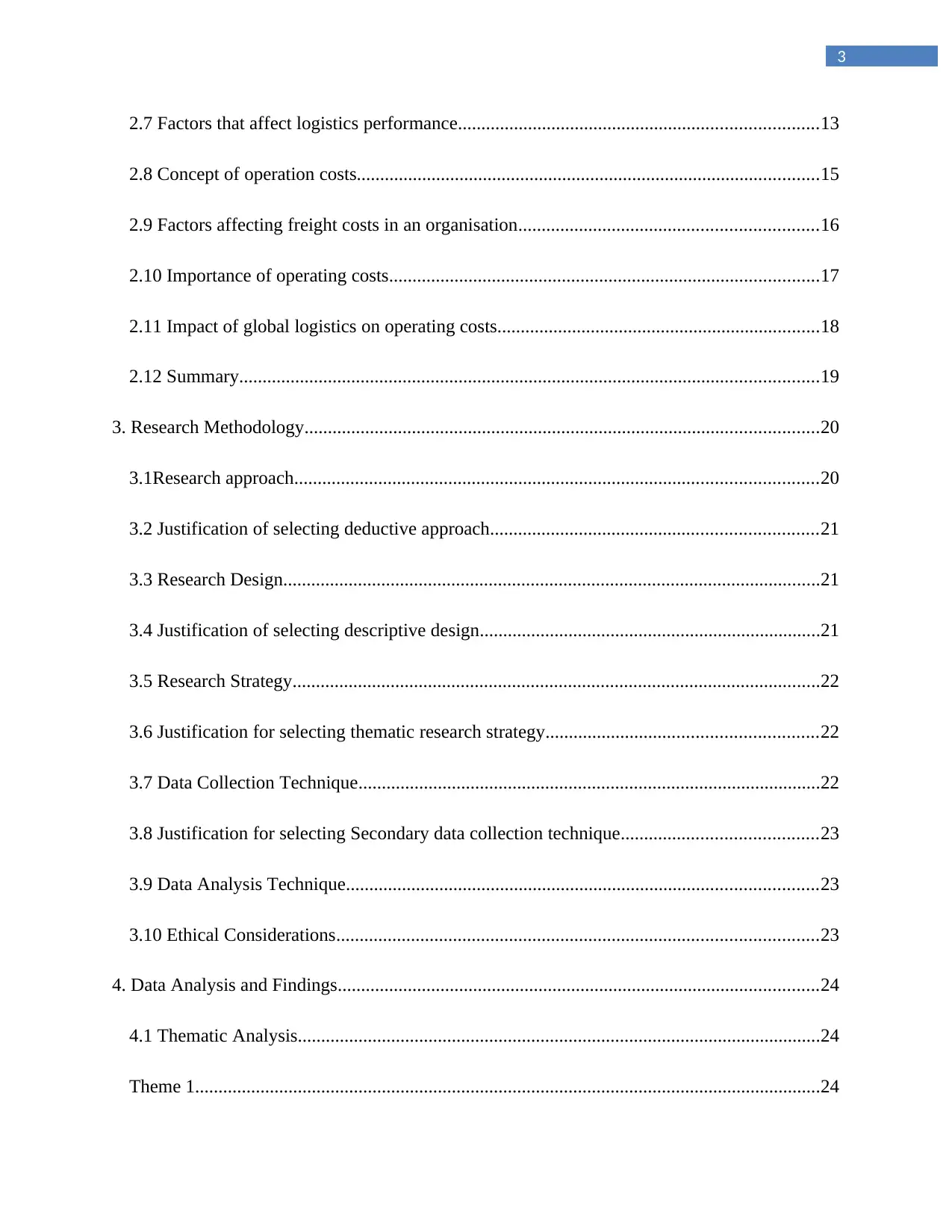
3
2.7 Factors that affect logistics performance.............................................................................13
2.8 Concept of operation costs...................................................................................................15
2.9 Factors affecting freight costs in an organisation................................................................16
2.10 Importance of operating costs............................................................................................17
2.11 Impact of global logistics on operating costs.....................................................................18
2.12 Summary............................................................................................................................19
3. Research Methodology..............................................................................................................20
3.1Research approach................................................................................................................20
3.2 Justification of selecting deductive approach......................................................................21
3.3 Research Design...................................................................................................................21
3.4 Justification of selecting descriptive design.........................................................................21
3.5 Research Strategy.................................................................................................................22
3.6 Justification for selecting thematic research strategy..........................................................22
3.7 Data Collection Technique...................................................................................................22
3.8 Justification for selecting Secondary data collection technique..........................................23
3.9 Data Analysis Technique.....................................................................................................23
3.10 Ethical Considerations.......................................................................................................23
4. Data Analysis and Findings.......................................................................................................24
4.1 Thematic Analysis................................................................................................................24
Theme 1......................................................................................................................................24
2.7 Factors that affect logistics performance.............................................................................13
2.8 Concept of operation costs...................................................................................................15
2.9 Factors affecting freight costs in an organisation................................................................16
2.10 Importance of operating costs............................................................................................17
2.11 Impact of global logistics on operating costs.....................................................................18
2.12 Summary............................................................................................................................19
3. Research Methodology..............................................................................................................20
3.1Research approach................................................................................................................20
3.2 Justification of selecting deductive approach......................................................................21
3.3 Research Design...................................................................................................................21
3.4 Justification of selecting descriptive design.........................................................................21
3.5 Research Strategy.................................................................................................................22
3.6 Justification for selecting thematic research strategy..........................................................22
3.7 Data Collection Technique...................................................................................................22
3.8 Justification for selecting Secondary data collection technique..........................................23
3.9 Data Analysis Technique.....................................................................................................23
3.10 Ethical Considerations.......................................................................................................23
4. Data Analysis and Findings.......................................................................................................24
4.1 Thematic Analysis................................................................................................................24
Theme 1......................................................................................................................................24
Secure Best Marks with AI Grader
Need help grading? Try our AI Grader for instant feedback on your assignments.
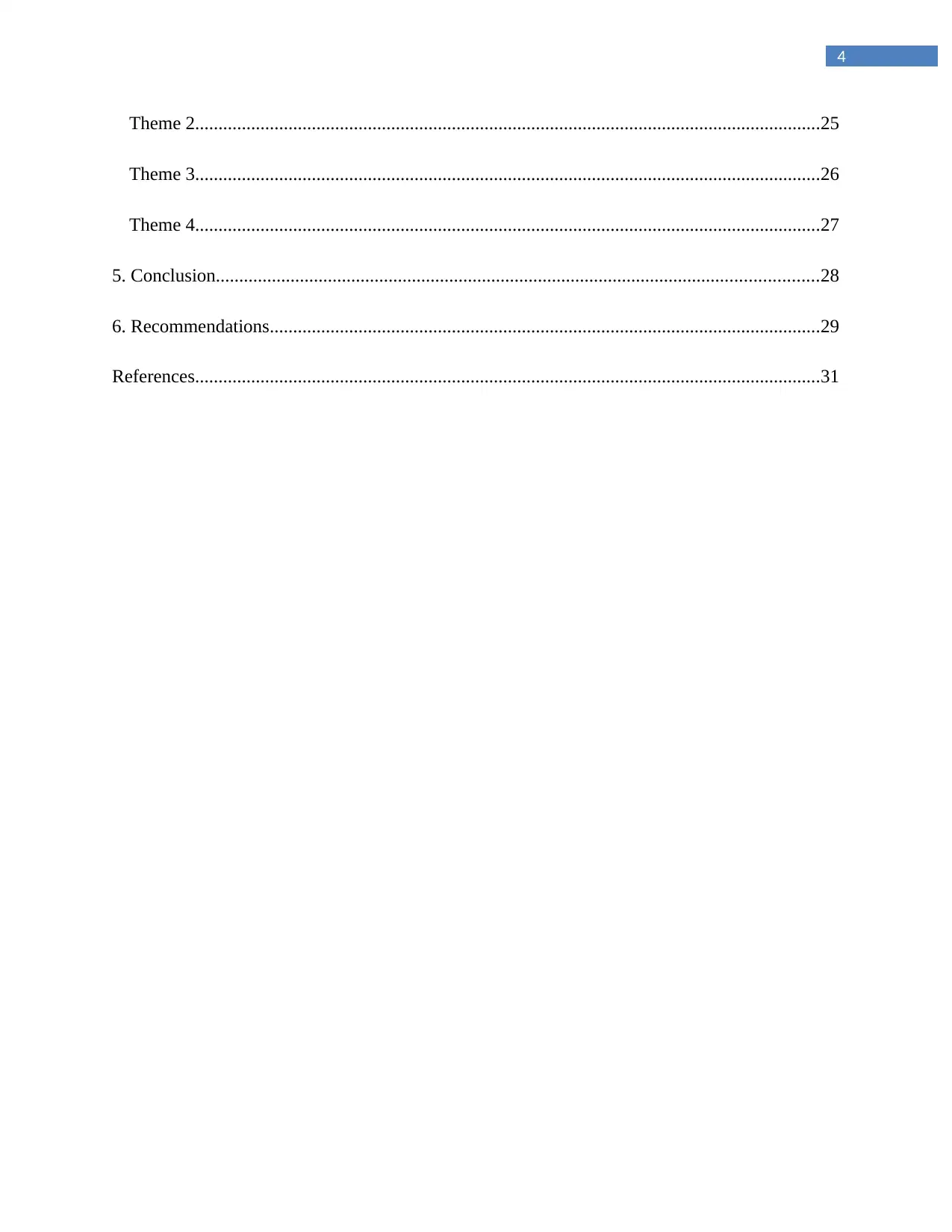
4
Theme 2......................................................................................................................................25
Theme 3......................................................................................................................................26
Theme 4......................................................................................................................................27
5. Conclusion.................................................................................................................................28
6. Recommendations......................................................................................................................29
References......................................................................................................................................31
Theme 2......................................................................................................................................25
Theme 3......................................................................................................................................26
Theme 4......................................................................................................................................27
5. Conclusion.................................................................................................................................28
6. Recommendations......................................................................................................................29
References......................................................................................................................................31
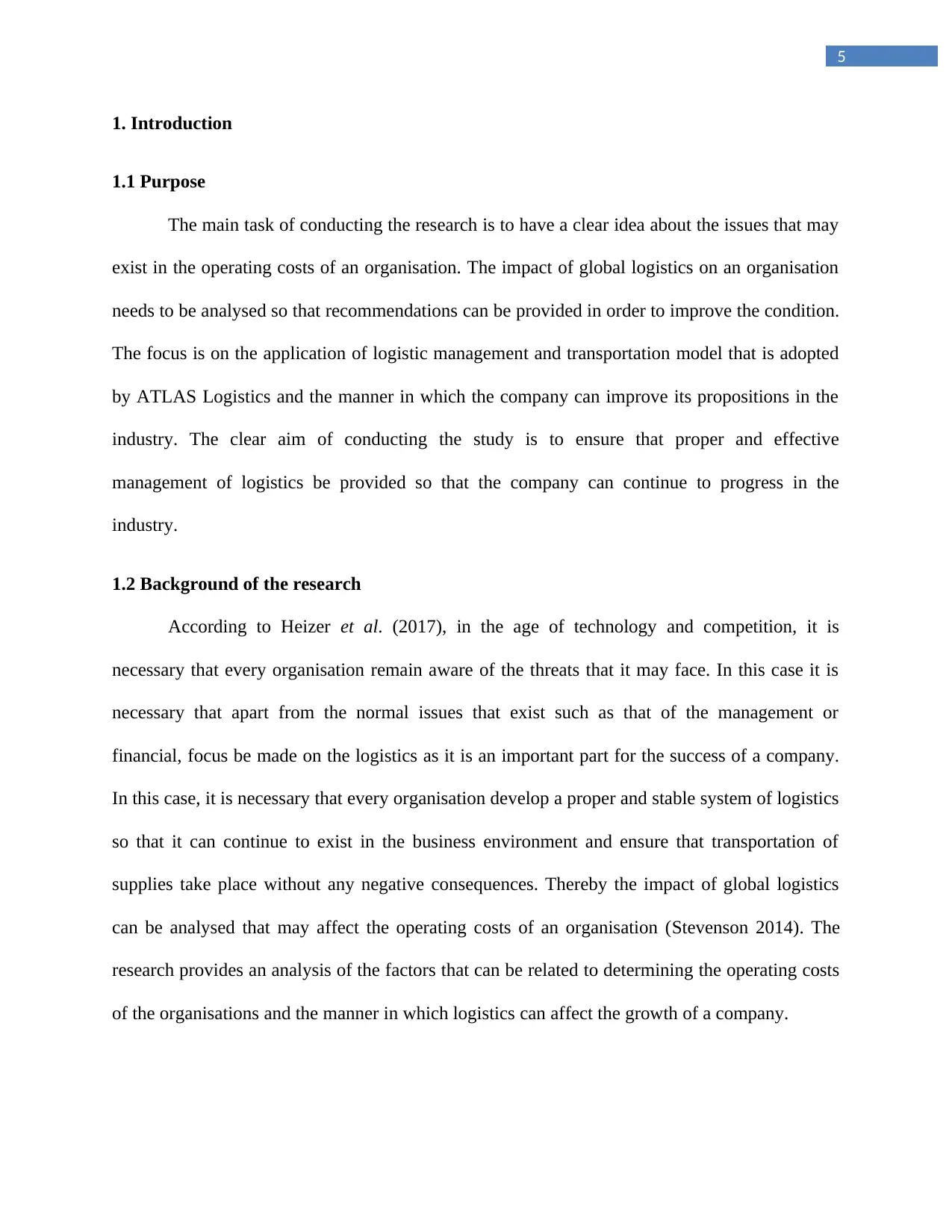
5
1. Introduction
1.1 Purpose
The main task of conducting the research is to have a clear idea about the issues that may
exist in the operating costs of an organisation. The impact of global logistics on an organisation
needs to be analysed so that recommendations can be provided in order to improve the condition.
The focus is on the application of logistic management and transportation model that is adopted
by ATLAS Logistics and the manner in which the company can improve its propositions in the
industry. The clear aim of conducting the study is to ensure that proper and effective
management of logistics be provided so that the company can continue to progress in the
industry.
1.2 Background of the research
According to Heizer et al. (2017), in the age of technology and competition, it is
necessary that every organisation remain aware of the threats that it may face. In this case it is
necessary that apart from the normal issues that exist such as that of the management or
financial, focus be made on the logistics as it is an important part for the success of a company.
In this case, it is necessary that every organisation develop a proper and stable system of logistics
so that it can continue to exist in the business environment and ensure that transportation of
supplies take place without any negative consequences. Thereby the impact of global logistics
can be analysed that may affect the operating costs of an organisation (Stevenson 2014). The
research provides an analysis of the factors that can be related to determining the operating costs
of the organisations and the manner in which logistics can affect the growth of a company.
1. Introduction
1.1 Purpose
The main task of conducting the research is to have a clear idea about the issues that may
exist in the operating costs of an organisation. The impact of global logistics on an organisation
needs to be analysed so that recommendations can be provided in order to improve the condition.
The focus is on the application of logistic management and transportation model that is adopted
by ATLAS Logistics and the manner in which the company can improve its propositions in the
industry. The clear aim of conducting the study is to ensure that proper and effective
management of logistics be provided so that the company can continue to progress in the
industry.
1.2 Background of the research
According to Heizer et al. (2017), in the age of technology and competition, it is
necessary that every organisation remain aware of the threats that it may face. In this case it is
necessary that apart from the normal issues that exist such as that of the management or
financial, focus be made on the logistics as it is an important part for the success of a company.
In this case, it is necessary that every organisation develop a proper and stable system of logistics
so that it can continue to exist in the business environment and ensure that transportation of
supplies take place without any negative consequences. Thereby the impact of global logistics
can be analysed that may affect the operating costs of an organisation (Stevenson 2014). The
research provides an analysis of the factors that can be related to determining the operating costs
of the organisations and the manner in which logistics can affect the growth of a company.
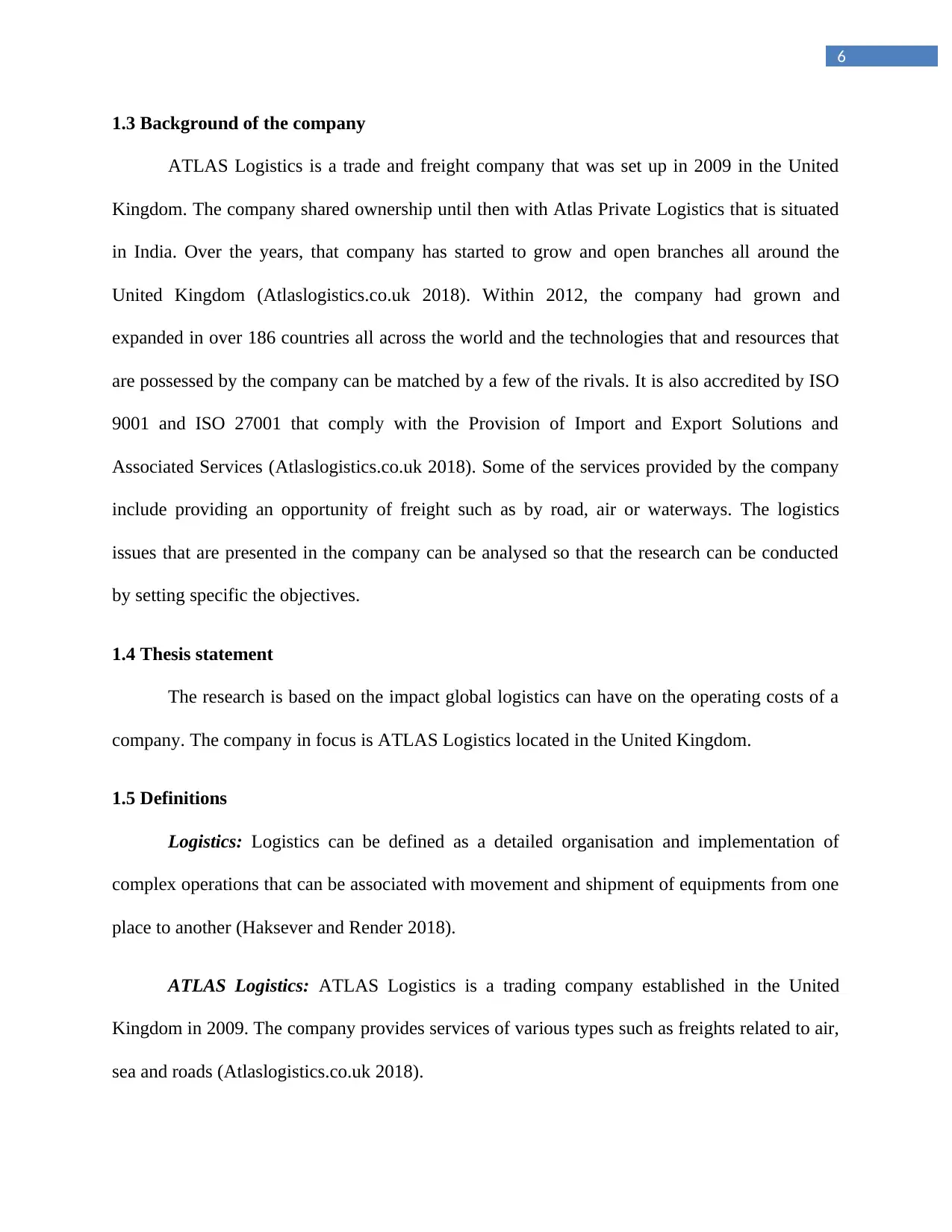
6
1.3 Background of the company
ATLAS Logistics is a trade and freight company that was set up in 2009 in the United
Kingdom. The company shared ownership until then with Atlas Private Logistics that is situated
in India. Over the years, that company has started to grow and open branches all around the
United Kingdom (Atlaslogistics.co.uk 2018). Within 2012, the company had grown and
expanded in over 186 countries all across the world and the technologies that and resources that
are possessed by the company can be matched by a few of the rivals. It is also accredited by ISO
9001 and ISO 27001 that comply with the Provision of Import and Export Solutions and
Associated Services (Atlaslogistics.co.uk 2018). Some of the services provided by the company
include providing an opportunity of freight such as by road, air or waterways. The logistics
issues that are presented in the company can be analysed so that the research can be conducted
by setting specific the objectives.
1.4 Thesis statement
The research is based on the impact global logistics can have on the operating costs of a
company. The company in focus is ATLAS Logistics located in the United Kingdom.
1.5 Definitions
Logistics: Logistics can be defined as a detailed organisation and implementation of
complex operations that can be associated with movement and shipment of equipments from one
place to another (Haksever and Render 2018).
ATLAS Logistics: ATLAS Logistics is a trading company established in the United
Kingdom in 2009. The company provides services of various types such as freights related to air,
sea and roads (Atlaslogistics.co.uk 2018).
1.3 Background of the company
ATLAS Logistics is a trade and freight company that was set up in 2009 in the United
Kingdom. The company shared ownership until then with Atlas Private Logistics that is situated
in India. Over the years, that company has started to grow and open branches all around the
United Kingdom (Atlaslogistics.co.uk 2018). Within 2012, the company had grown and
expanded in over 186 countries all across the world and the technologies that and resources that
are possessed by the company can be matched by a few of the rivals. It is also accredited by ISO
9001 and ISO 27001 that comply with the Provision of Import and Export Solutions and
Associated Services (Atlaslogistics.co.uk 2018). Some of the services provided by the company
include providing an opportunity of freight such as by road, air or waterways. The logistics
issues that are presented in the company can be analysed so that the research can be conducted
by setting specific the objectives.
1.4 Thesis statement
The research is based on the impact global logistics can have on the operating costs of a
company. The company in focus is ATLAS Logistics located in the United Kingdom.
1.5 Definitions
Logistics: Logistics can be defined as a detailed organisation and implementation of
complex operations that can be associated with movement and shipment of equipments from one
place to another (Haksever and Render 2018).
ATLAS Logistics: ATLAS Logistics is a trading company established in the United
Kingdom in 2009. The company provides services of various types such as freights related to air,
sea and roads (Atlaslogistics.co.uk 2018).
Paraphrase This Document
Need a fresh take? Get an instant paraphrase of this document with our AI Paraphraser
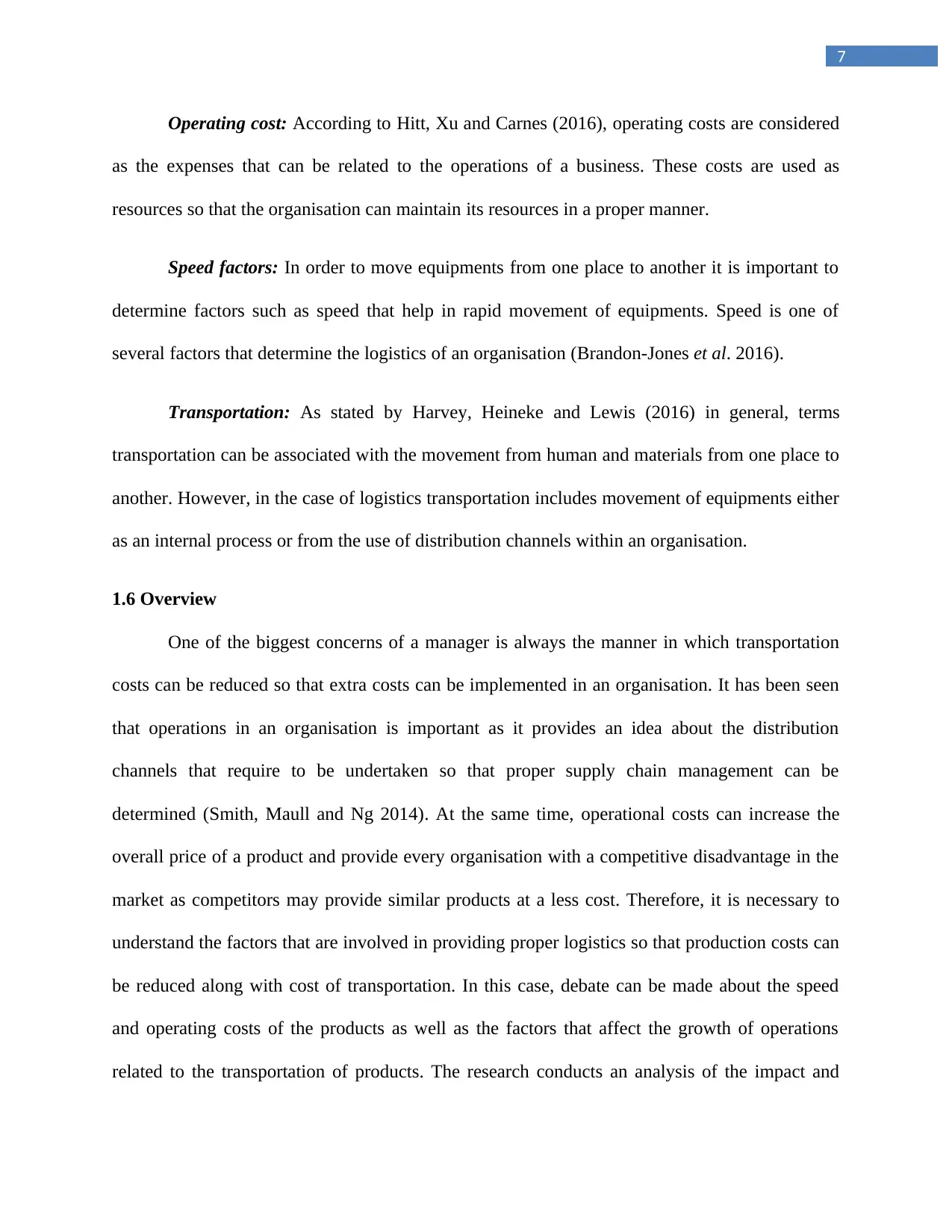
7
Operating cost: According to Hitt, Xu and Carnes (2016), operating costs are considered
as the expenses that can be related to the operations of a business. These costs are used as
resources so that the organisation can maintain its resources in a proper manner.
Speed factors: In order to move equipments from one place to another it is important to
determine factors such as speed that help in rapid movement of equipments. Speed is one of
several factors that determine the logistics of an organisation (Brandon-Jones et al. 2016).
Transportation: As stated by Harvey, Heineke and Lewis (2016) in general, terms
transportation can be associated with the movement from human and materials from one place to
another. However, in the case of logistics transportation includes movement of equipments either
as an internal process or from the use of distribution channels within an organisation.
1.6 Overview
One of the biggest concerns of a manager is always the manner in which transportation
costs can be reduced so that extra costs can be implemented in an organisation. It has been seen
that operations in an organisation is important as it provides an idea about the distribution
channels that require to be undertaken so that proper supply chain management can be
determined (Smith, Maull and Ng 2014). At the same time, operational costs can increase the
overall price of a product and provide every organisation with a competitive disadvantage in the
market as competitors may provide similar products at a less cost. Therefore, it is necessary to
understand the factors that are involved in providing proper logistics so that production costs can
be reduced along with cost of transportation. In this case, debate can be made about the speed
and operating costs of the products as well as the factors that affect the growth of operations
related to the transportation of products. The research conducts an analysis of the impact and
Operating cost: According to Hitt, Xu and Carnes (2016), operating costs are considered
as the expenses that can be related to the operations of a business. These costs are used as
resources so that the organisation can maintain its resources in a proper manner.
Speed factors: In order to move equipments from one place to another it is important to
determine factors such as speed that help in rapid movement of equipments. Speed is one of
several factors that determine the logistics of an organisation (Brandon-Jones et al. 2016).
Transportation: As stated by Harvey, Heineke and Lewis (2016) in general, terms
transportation can be associated with the movement from human and materials from one place to
another. However, in the case of logistics transportation includes movement of equipments either
as an internal process or from the use of distribution channels within an organisation.
1.6 Overview
One of the biggest concerns of a manager is always the manner in which transportation
costs can be reduced so that extra costs can be implemented in an organisation. It has been seen
that operations in an organisation is important as it provides an idea about the distribution
channels that require to be undertaken so that proper supply chain management can be
determined (Smith, Maull and Ng 2014). At the same time, operational costs can increase the
overall price of a product and provide every organisation with a competitive disadvantage in the
market as competitors may provide similar products at a less cost. Therefore, it is necessary to
understand the factors that are involved in providing proper logistics so that production costs can
be reduced along with cost of transportation. In this case, debate can be made about the speed
and operating costs of the products as well as the factors that affect the growth of operations
related to the transportation of products. The research conducts an analysis of the impact and
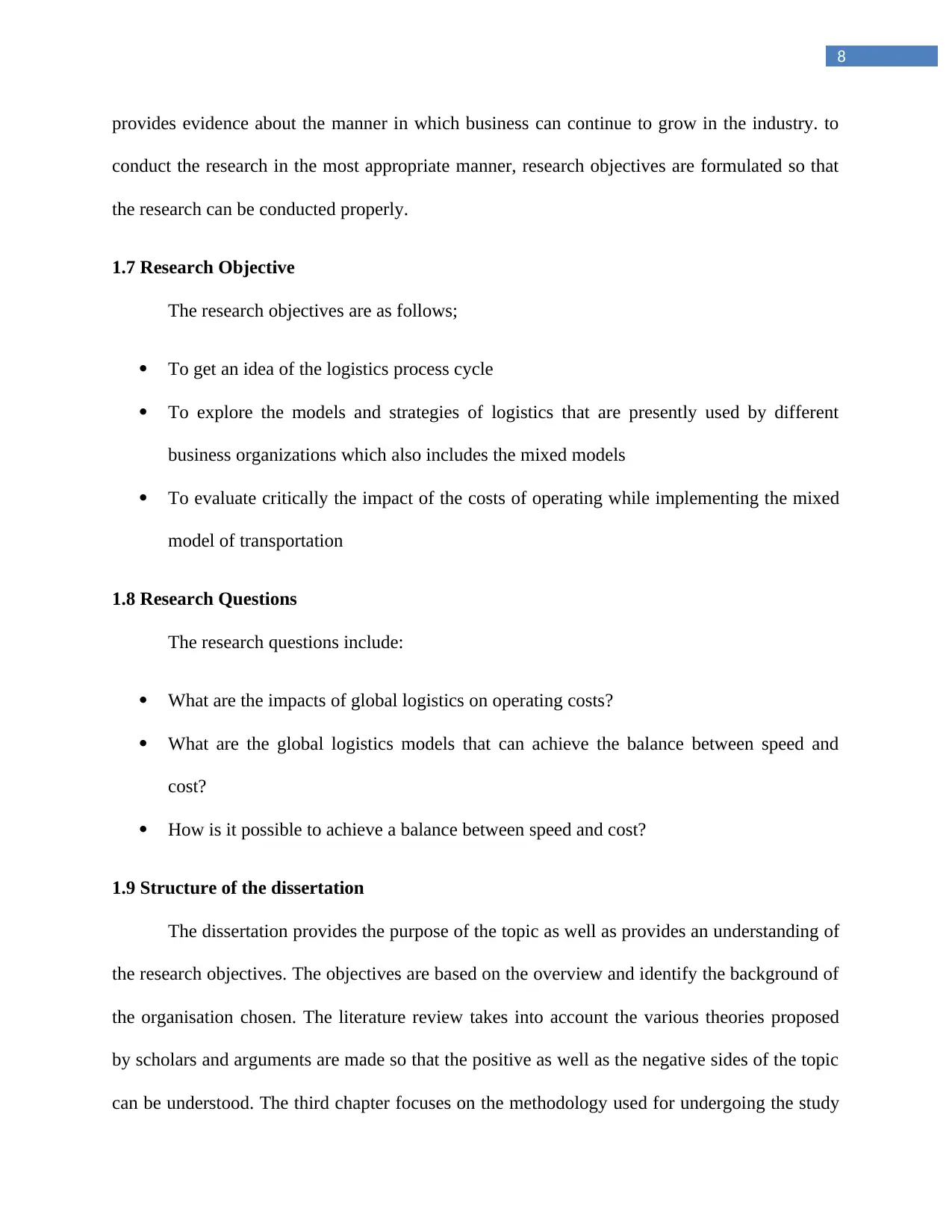
8
provides evidence about the manner in which business can continue to grow in the industry. to
conduct the research in the most appropriate manner, research objectives are formulated so that
the research can be conducted properly.
1.7 Research Objective
The research objectives are as follows;
To get an idea of the logistics process cycle
To explore the models and strategies of logistics that are presently used by different
business organizations which also includes the mixed models
To evaluate critically the impact of the costs of operating while implementing the mixed
model of transportation
1.8 Research Questions
The research questions include:
What are the impacts of global logistics on operating costs?
What are the global logistics models that can achieve the balance between speed and
cost?
How is it possible to achieve a balance between speed and cost?
1.9 Structure of the dissertation
The dissertation provides the purpose of the topic as well as provides an understanding of
the research objectives. The objectives are based on the overview and identify the background of
the organisation chosen. The literature review takes into account the various theories proposed
by scholars and arguments are made so that the positive as well as the negative sides of the topic
can be understood. The third chapter focuses on the methodology used for undergoing the study
provides evidence about the manner in which business can continue to grow in the industry. to
conduct the research in the most appropriate manner, research objectives are formulated so that
the research can be conducted properly.
1.7 Research Objective
The research objectives are as follows;
To get an idea of the logistics process cycle
To explore the models and strategies of logistics that are presently used by different
business organizations which also includes the mixed models
To evaluate critically the impact of the costs of operating while implementing the mixed
model of transportation
1.8 Research Questions
The research questions include:
What are the impacts of global logistics on operating costs?
What are the global logistics models that can achieve the balance between speed and
cost?
How is it possible to achieve a balance between speed and cost?
1.9 Structure of the dissertation
The dissertation provides the purpose of the topic as well as provides an understanding of
the research objectives. The objectives are based on the overview and identify the background of
the organisation chosen. The literature review takes into account the various theories proposed
by scholars and arguments are made so that the positive as well as the negative sides of the topic
can be understood. The third chapter focuses on the methodology used for undergoing the study
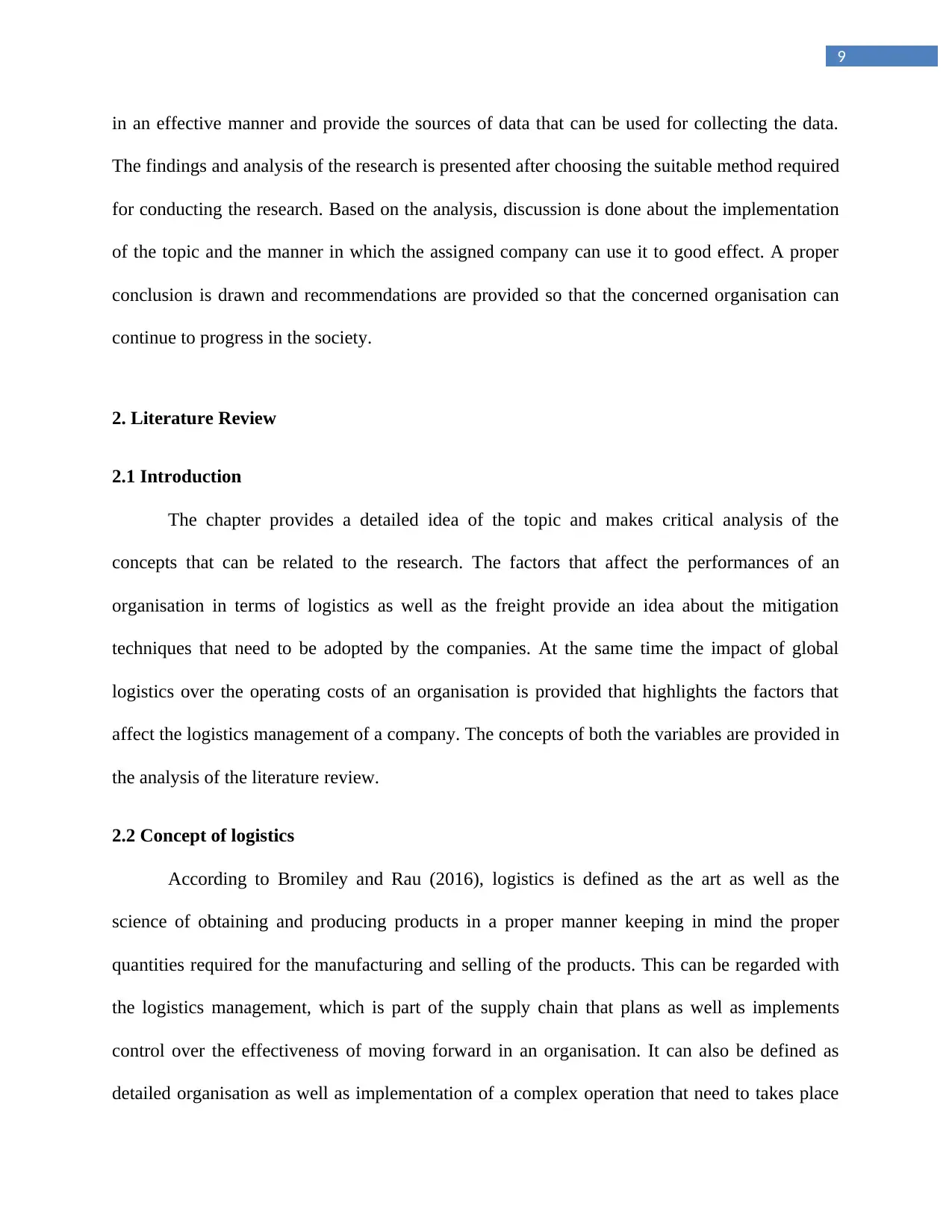
9
in an effective manner and provide the sources of data that can be used for collecting the data.
The findings and analysis of the research is presented after choosing the suitable method required
for conducting the research. Based on the analysis, discussion is done about the implementation
of the topic and the manner in which the assigned company can use it to good effect. A proper
conclusion is drawn and recommendations are provided so that the concerned organisation can
continue to progress in the society.
2. Literature Review
2.1 Introduction
The chapter provides a detailed idea of the topic and makes critical analysis of the
concepts that can be related to the research. The factors that affect the performances of an
organisation in terms of logistics as well as the freight provide an idea about the mitigation
techniques that need to be adopted by the companies. At the same time the impact of global
logistics over the operating costs of an organisation is provided that highlights the factors that
affect the logistics management of a company. The concepts of both the variables are provided in
the analysis of the literature review.
2.2 Concept of logistics
According to Bromiley and Rau (2016), logistics is defined as the art as well as the
science of obtaining and producing products in a proper manner keeping in mind the proper
quantities required for the manufacturing and selling of the products. This can be regarded with
the logistics management, which is part of the supply chain that plans as well as implements
control over the effectiveness of moving forward in an organisation. It can also be defined as
detailed organisation as well as implementation of a complex operation that need to takes place
in an effective manner and provide the sources of data that can be used for collecting the data.
The findings and analysis of the research is presented after choosing the suitable method required
for conducting the research. Based on the analysis, discussion is done about the implementation
of the topic and the manner in which the assigned company can use it to good effect. A proper
conclusion is drawn and recommendations are provided so that the concerned organisation can
continue to progress in the society.
2. Literature Review
2.1 Introduction
The chapter provides a detailed idea of the topic and makes critical analysis of the
concepts that can be related to the research. The factors that affect the performances of an
organisation in terms of logistics as well as the freight provide an idea about the mitigation
techniques that need to be adopted by the companies. At the same time the impact of global
logistics over the operating costs of an organisation is provided that highlights the factors that
affect the logistics management of a company. The concepts of both the variables are provided in
the analysis of the literature review.
2.2 Concept of logistics
According to Bromiley and Rau (2016), logistics is defined as the art as well as the
science of obtaining and producing products in a proper manner keeping in mind the proper
quantities required for the manufacturing and selling of the products. This can be regarded with
the logistics management, which is part of the supply chain that plans as well as implements
control over the effectiveness of moving forward in an organisation. It can also be defined as
detailed organisation as well as implementation of a complex operation that need to takes place
Secure Best Marks with AI Grader
Need help grading? Try our AI Grader for instant feedback on your assignments.
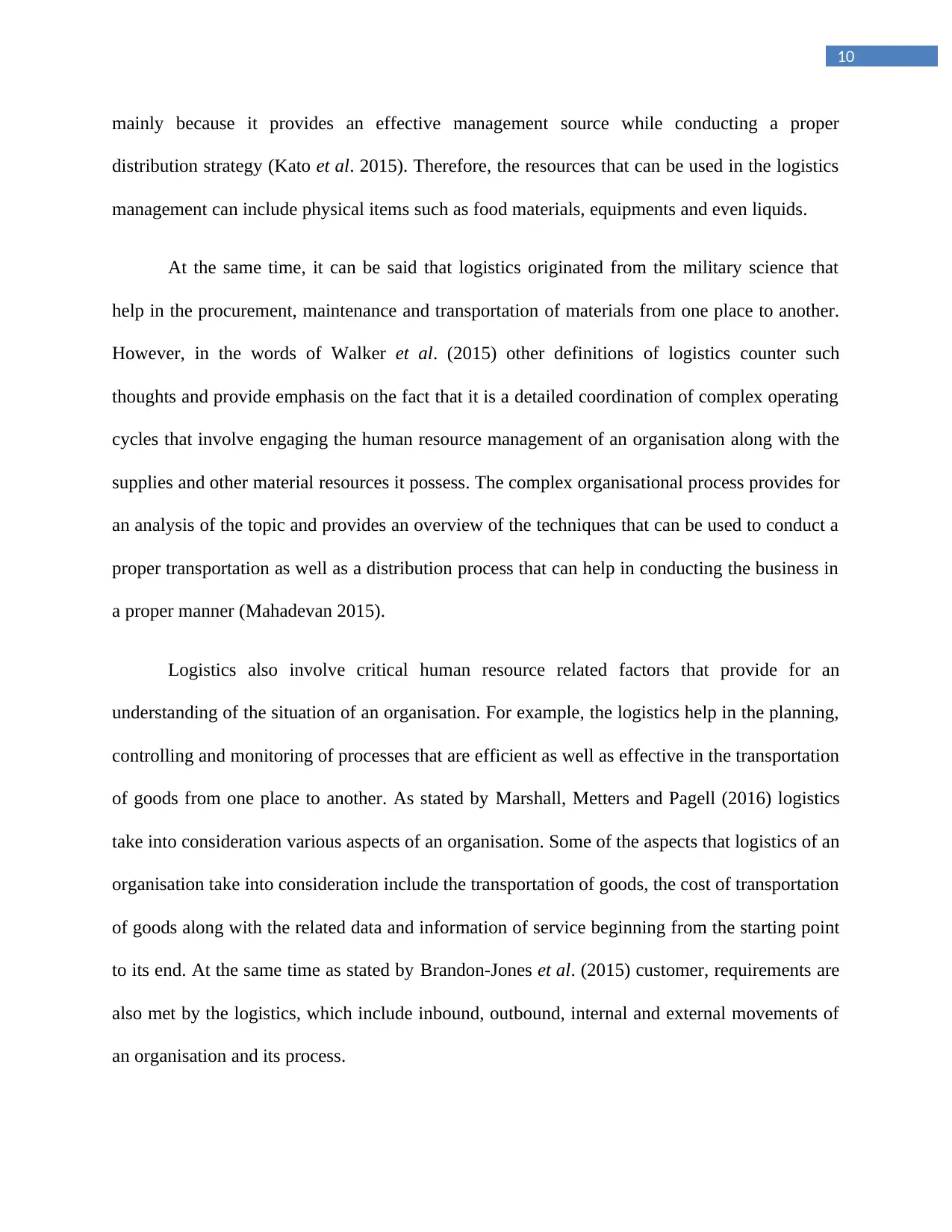
10
mainly because it provides an effective management source while conducting a proper
distribution strategy (Kato et al. 2015). Therefore, the resources that can be used in the logistics
management can include physical items such as food materials, equipments and even liquids.
At the same time, it can be said that logistics originated from the military science that
help in the procurement, maintenance and transportation of materials from one place to another.
However, in the words of Walker et al. (2015) other definitions of logistics counter such
thoughts and provide emphasis on the fact that it is a detailed coordination of complex operating
cycles that involve engaging the human resource management of an organisation along with the
supplies and other material resources it possess. The complex organisational process provides for
an analysis of the topic and provides an overview of the techniques that can be used to conduct a
proper transportation as well as a distribution process that can help in conducting the business in
a proper manner (Mahadevan 2015).
Logistics also involve critical human resource related factors that provide for an
understanding of the situation of an organisation. For example, the logistics help in the planning,
controlling and monitoring of processes that are efficient as well as effective in the transportation
of goods from one place to another. As stated by Marshall, Metters and Pagell (2016) logistics
take into consideration various aspects of an organisation. Some of the aspects that logistics of an
organisation take into consideration include the transportation of goods, the cost of transportation
of goods along with the related data and information of service beginning from the starting point
to its end. At the same time as stated by Brandon-Jones et al. (2015) customer, requirements are
also met by the logistics, which include inbound, outbound, internal and external movements of
an organisation and its process.
mainly because it provides an effective management source while conducting a proper
distribution strategy (Kato et al. 2015). Therefore, the resources that can be used in the logistics
management can include physical items such as food materials, equipments and even liquids.
At the same time, it can be said that logistics originated from the military science that
help in the procurement, maintenance and transportation of materials from one place to another.
However, in the words of Walker et al. (2015) other definitions of logistics counter such
thoughts and provide emphasis on the fact that it is a detailed coordination of complex operating
cycles that involve engaging the human resource management of an organisation along with the
supplies and other material resources it possess. The complex organisational process provides for
an analysis of the topic and provides an overview of the techniques that can be used to conduct a
proper transportation as well as a distribution process that can help in conducting the business in
a proper manner (Mahadevan 2015).
Logistics also involve critical human resource related factors that provide for an
understanding of the situation of an organisation. For example, the logistics help in the planning,
controlling and monitoring of processes that are efficient as well as effective in the transportation
of goods from one place to another. As stated by Marshall, Metters and Pagell (2016) logistics
take into consideration various aspects of an organisation. Some of the aspects that logistics of an
organisation take into consideration include the transportation of goods, the cost of transportation
of goods along with the related data and information of service beginning from the starting point
to its end. At the same time as stated by Brandon-Jones et al. (2015) customer, requirements are
also met by the logistics, which include inbound, outbound, internal and external movements of
an organisation and its process.
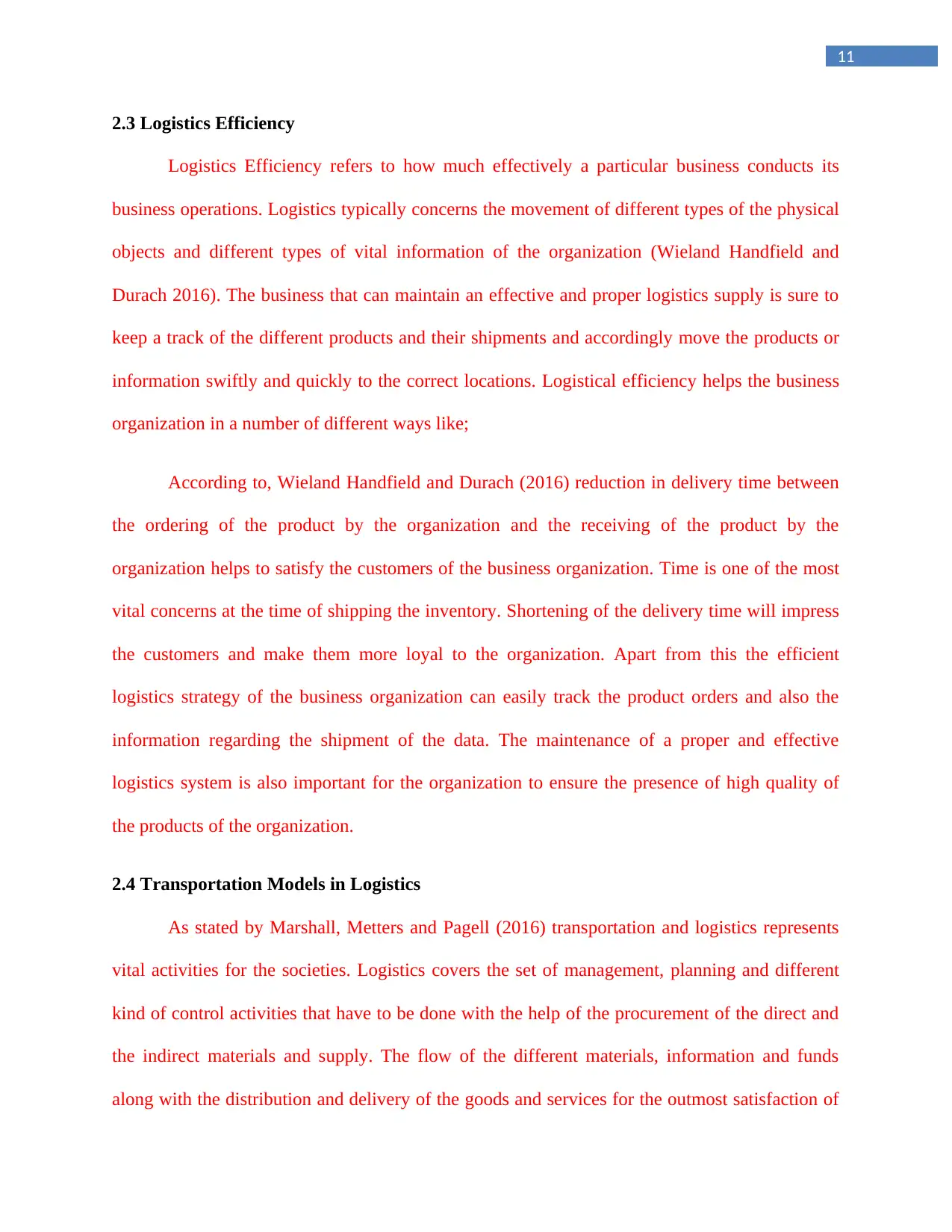
11
2.3 Logistics Efficiency
Logistics Efficiency refers to how much effectively a particular business conducts its
business operations. Logistics typically concerns the movement of different types of the physical
objects and different types of vital information of the organization (Wieland Handfield and
Durach 2016). The business that can maintain an effective and proper logistics supply is sure to
keep a track of the different products and their shipments and accordingly move the products or
information swiftly and quickly to the correct locations. Logistical efficiency helps the business
organization in a number of different ways like;
According to, Wieland Handfield and Durach (2016) reduction in delivery time between
the ordering of the product by the organization and the receiving of the product by the
organization helps to satisfy the customers of the business organization. Time is one of the most
vital concerns at the time of shipping the inventory. Shortening of the delivery time will impress
the customers and make them more loyal to the organization. Apart from this the efficient
logistics strategy of the business organization can easily track the product orders and also the
information regarding the shipment of the data. The maintenance of a proper and effective
logistics system is also important for the organization to ensure the presence of high quality of
the products of the organization.
2.4 Transportation Models in Logistics
As stated by Marshall, Metters and Pagell (2016) transportation and logistics represents
vital activities for the societies. Logistics covers the set of management, planning and different
kind of control activities that have to be done with the help of the procurement of the direct and
the indirect materials and supply. The flow of the different materials, information and funds
along with the distribution and delivery of the goods and services for the outmost satisfaction of
2.3 Logistics Efficiency
Logistics Efficiency refers to how much effectively a particular business conducts its
business operations. Logistics typically concerns the movement of different types of the physical
objects and different types of vital information of the organization (Wieland Handfield and
Durach 2016). The business that can maintain an effective and proper logistics supply is sure to
keep a track of the different products and their shipments and accordingly move the products or
information swiftly and quickly to the correct locations. Logistical efficiency helps the business
organization in a number of different ways like;
According to, Wieland Handfield and Durach (2016) reduction in delivery time between
the ordering of the product by the organization and the receiving of the product by the
organization helps to satisfy the customers of the business organization. Time is one of the most
vital concerns at the time of shipping the inventory. Shortening of the delivery time will impress
the customers and make them more loyal to the organization. Apart from this the efficient
logistics strategy of the business organization can easily track the product orders and also the
information regarding the shipment of the data. The maintenance of a proper and effective
logistics system is also important for the organization to ensure the presence of high quality of
the products of the organization.
2.4 Transportation Models in Logistics
As stated by Marshall, Metters and Pagell (2016) transportation and logistics represents
vital activities for the societies. Logistics covers the set of management, planning and different
kind of control activities that have to be done with the help of the procurement of the direct and
the indirect materials and supply. The flow of the different materials, information and funds
along with the distribution and delivery of the goods and services for the outmost satisfaction of

12
the customers is important for the profitability of the business organization. The management of
Atlas Logistics have a rolling stock of Renault Optifuel trucks and Mercedes trucks that they use
in all the different kinds of transportation activities. However, the management of the
organization is also recently in talks with Nissan Trucks to complete the formality of buying
medium sized trucks to ensure the smooth transfer of goods via these trucks in areas of great
distress or in times of lack of adequate infrastructure for the large trucks.
2.5 Differentiation of Logistics
The main categories that divide logistics are as follows;
a. 1PL Logistics- The first party logistic provider is the company which do not outsources
transport and the activities related to logistics to the third person (Mackelprang et al.
2014). The person who moves its goods to one place from another may be called as a 1PL
provider.
b. 2PL Logistics- The second party logistic provider generally have the tendency to own the
different means of the transportation. They have their own trucks, ships, airlines and also
provide different services for lease.
c. 3PL Logistics- According to Bromiley and Rau (2016) the manufacturer of the products
that are to be send to the customers are done through the likes of the 3PL Logistic
providers. These people are responsible for the transportation, warehousing, packaging
and the management of the inventory and rolling stock of the organization.
d. 4PL Logistics- The fourth party logistics providers manages the entire functions of the
supply chain like the procurement, storage, division, distribution and the processes. on
the other hand 3PL concentrates only on a single function within the Logistics.
the customers is important for the profitability of the business organization. The management of
Atlas Logistics have a rolling stock of Renault Optifuel trucks and Mercedes trucks that they use
in all the different kinds of transportation activities. However, the management of the
organization is also recently in talks with Nissan Trucks to complete the formality of buying
medium sized trucks to ensure the smooth transfer of goods via these trucks in areas of great
distress or in times of lack of adequate infrastructure for the large trucks.
2.5 Differentiation of Logistics
The main categories that divide logistics are as follows;
a. 1PL Logistics- The first party logistic provider is the company which do not outsources
transport and the activities related to logistics to the third person (Mackelprang et al.
2014). The person who moves its goods to one place from another may be called as a 1PL
provider.
b. 2PL Logistics- The second party logistic provider generally have the tendency to own the
different means of the transportation. They have their own trucks, ships, airlines and also
provide different services for lease.
c. 3PL Logistics- According to Bromiley and Rau (2016) the manufacturer of the products
that are to be send to the customers are done through the likes of the 3PL Logistic
providers. These people are responsible for the transportation, warehousing, packaging
and the management of the inventory and rolling stock of the organization.
d. 4PL Logistics- The fourth party logistics providers manages the entire functions of the
supply chain like the procurement, storage, division, distribution and the processes. on
the other hand 3PL concentrates only on a single function within the Logistics.
Paraphrase This Document
Need a fresh take? Get an instant paraphrase of this document with our AI Paraphraser
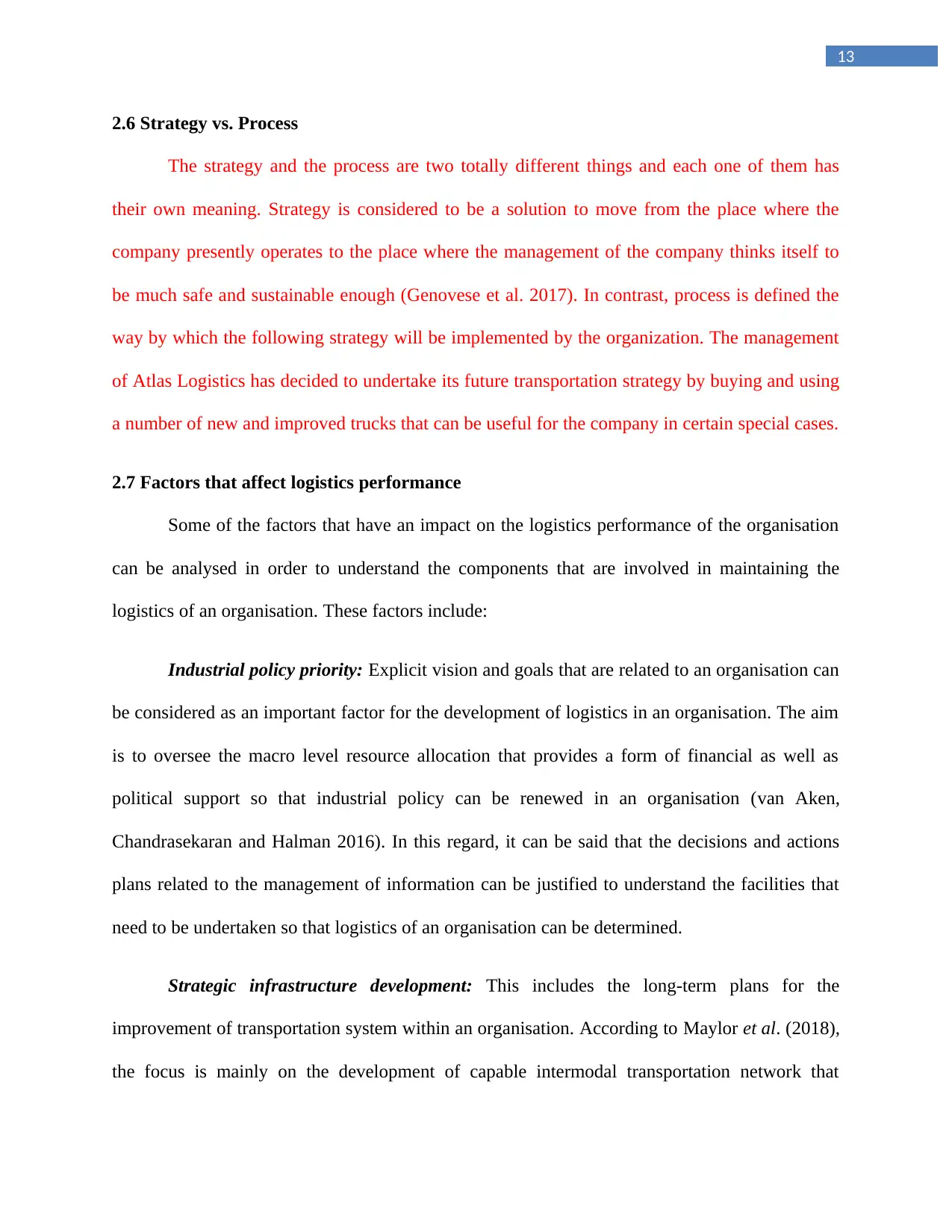
13
2.6 Strategy vs. Process
The strategy and the process are two totally different things and each one of them has
their own meaning. Strategy is considered to be a solution to move from the place where the
company presently operates to the place where the management of the company thinks itself to
be much safe and sustainable enough (Genovese et al. 2017). In contrast, process is defined the
way by which the following strategy will be implemented by the organization. The management
of Atlas Logistics has decided to undertake its future transportation strategy by buying and using
a number of new and improved trucks that can be useful for the company in certain special cases.
2.7 Factors that affect logistics performance
Some of the factors that have an impact on the logistics performance of the organisation
can be analysed in order to understand the components that are involved in maintaining the
logistics of an organisation. These factors include:
Industrial policy priority: Explicit vision and goals that are related to an organisation can
be considered as an important factor for the development of logistics in an organisation. The aim
is to oversee the macro level resource allocation that provides a form of financial as well as
political support so that industrial policy can be renewed in an organisation (van Aken,
Chandrasekaran and Halman 2016). In this regard, it can be said that the decisions and actions
plans related to the management of information can be justified to understand the facilities that
need to be undertaken so that logistics of an organisation can be determined.
Strategic infrastructure development: This includes the long-term plans for the
improvement of transportation system within an organisation. According to Maylor et al. (2018),
the focus is mainly on the development of capable intermodal transportation network that
2.6 Strategy vs. Process
The strategy and the process are two totally different things and each one of them has
their own meaning. Strategy is considered to be a solution to move from the place where the
company presently operates to the place where the management of the company thinks itself to
be much safe and sustainable enough (Genovese et al. 2017). In contrast, process is defined the
way by which the following strategy will be implemented by the organization. The management
of Atlas Logistics has decided to undertake its future transportation strategy by buying and using
a number of new and improved trucks that can be useful for the company in certain special cases.
2.7 Factors that affect logistics performance
Some of the factors that have an impact on the logistics performance of the organisation
can be analysed in order to understand the components that are involved in maintaining the
logistics of an organisation. These factors include:
Industrial policy priority: Explicit vision and goals that are related to an organisation can
be considered as an important factor for the development of logistics in an organisation. The aim
is to oversee the macro level resource allocation that provides a form of financial as well as
political support so that industrial policy can be renewed in an organisation (van Aken,
Chandrasekaran and Halman 2016). In this regard, it can be said that the decisions and actions
plans related to the management of information can be justified to understand the facilities that
need to be undertaken so that logistics of an organisation can be determined.
Strategic infrastructure development: This includes the long-term plans for the
improvement of transportation system within an organisation. According to Maylor et al. (2018),
the focus is mainly on the development of capable intermodal transportation network that
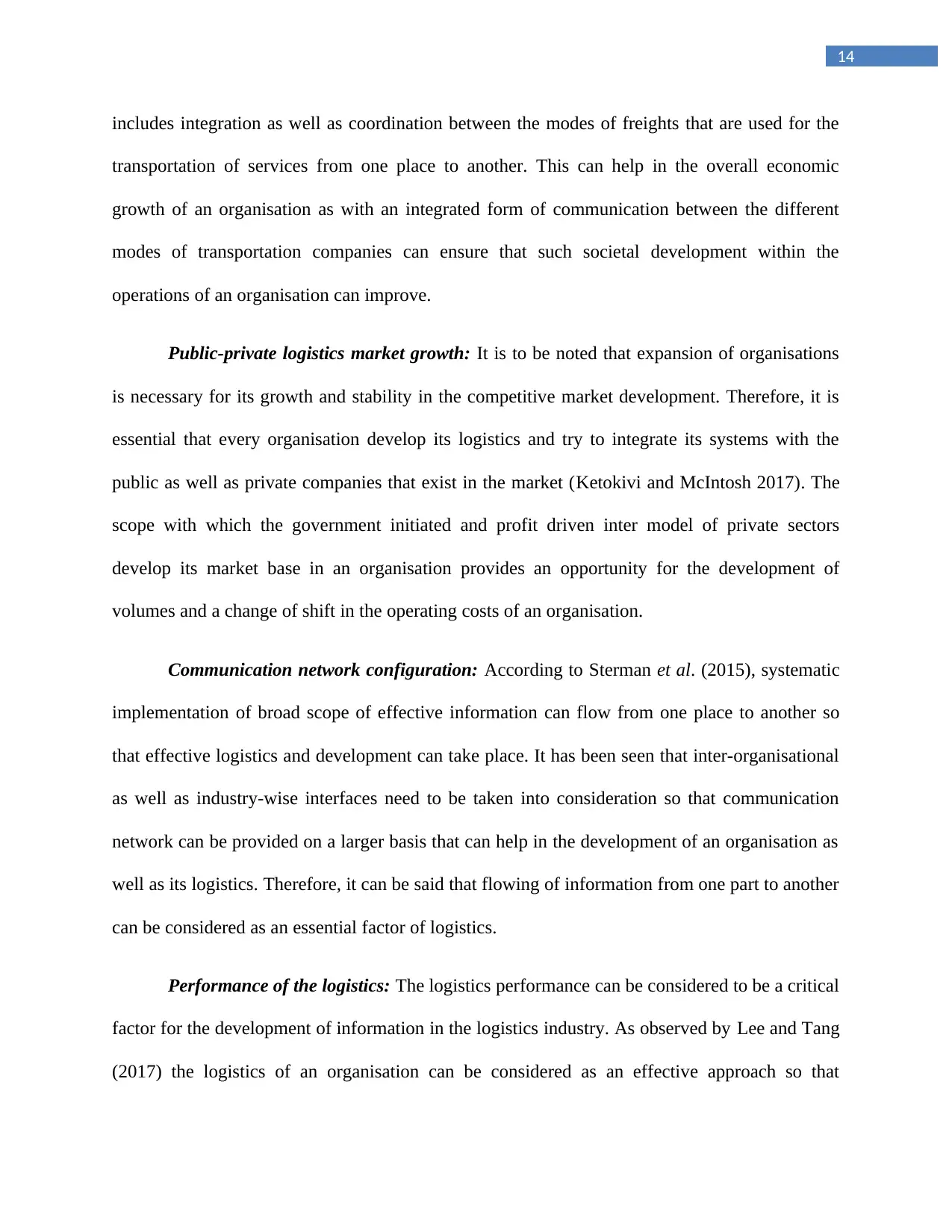
14
includes integration as well as coordination between the modes of freights that are used for the
transportation of services from one place to another. This can help in the overall economic
growth of an organisation as with an integrated form of communication between the different
modes of transportation companies can ensure that such societal development within the
operations of an organisation can improve.
Public-private logistics market growth: It is to be noted that expansion of organisations
is necessary for its growth and stability in the competitive market development. Therefore, it is
essential that every organisation develop its logistics and try to integrate its systems with the
public as well as private companies that exist in the market (Ketokivi and McIntosh 2017). The
scope with which the government initiated and profit driven inter model of private sectors
develop its market base in an organisation provides an opportunity for the development of
volumes and a change of shift in the operating costs of an organisation.
Communication network configuration: According to Sterman et al. (2015), systematic
implementation of broad scope of effective information can flow from one place to another so
that effective logistics and development can take place. It has been seen that inter-organisational
as well as industry-wise interfaces need to be taken into consideration so that communication
network can be provided on a larger basis that can help in the development of an organisation as
well as its logistics. Therefore, it can be said that flowing of information from one part to another
can be considered as an essential factor of logistics.
Performance of the logistics: The logistics performance can be considered to be a critical
factor for the development of information in the logistics industry. As observed by Lee and Tang
(2017) the logistics of an organisation can be considered as an effective approach so that
includes integration as well as coordination between the modes of freights that are used for the
transportation of services from one place to another. This can help in the overall economic
growth of an organisation as with an integrated form of communication between the different
modes of transportation companies can ensure that such societal development within the
operations of an organisation can improve.
Public-private logistics market growth: It is to be noted that expansion of organisations
is necessary for its growth and stability in the competitive market development. Therefore, it is
essential that every organisation develop its logistics and try to integrate its systems with the
public as well as private companies that exist in the market (Ketokivi and McIntosh 2017). The
scope with which the government initiated and profit driven inter model of private sectors
develop its market base in an organisation provides an opportunity for the development of
volumes and a change of shift in the operating costs of an organisation.
Communication network configuration: According to Sterman et al. (2015), systematic
implementation of broad scope of effective information can flow from one place to another so
that effective logistics and development can take place. It has been seen that inter-organisational
as well as industry-wise interfaces need to be taken into consideration so that communication
network can be provided on a larger basis that can help in the development of an organisation as
well as its logistics. Therefore, it can be said that flowing of information from one part to another
can be considered as an essential factor of logistics.
Performance of the logistics: The logistics performance can be considered to be a critical
factor for the development of information in the logistics industry. As observed by Lee and Tang
(2017) the logistics of an organisation can be considered as an effective approach so that
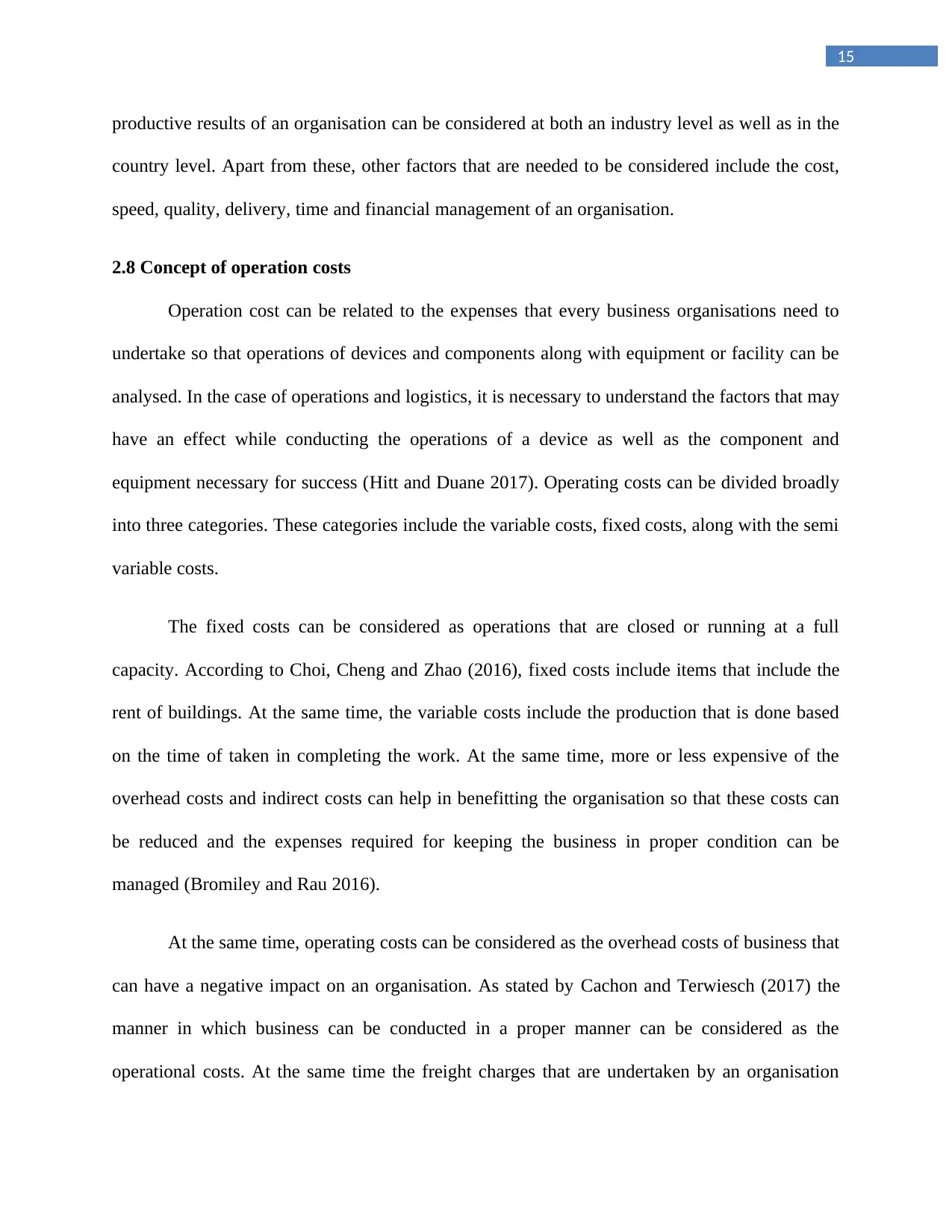
15
productive results of an organisation can be considered at both an industry level as well as in the
country level. Apart from these, other factors that are needed to be considered include the cost,
speed, quality, delivery, time and financial management of an organisation.
2.8 Concept of operation costs
Operation cost can be related to the expenses that every business organisations need to
undertake so that operations of devices and components along with equipment or facility can be
analysed. In the case of operations and logistics, it is necessary to understand the factors that may
have an effect while conducting the operations of a device as well as the component and
equipment necessary for success (Hitt and Duane 2017). Operating costs can be divided broadly
into three categories. These categories include the variable costs, fixed costs, along with the semi
variable costs.
The fixed costs can be considered as operations that are closed or running at a full
capacity. According to Choi, Cheng and Zhao (2016), fixed costs include items that include the
rent of buildings. At the same time, the variable costs include the production that is done based
on the time of taken in completing the work. At the same time, more or less expensive of the
overhead costs and indirect costs can help in benefitting the organisation so that these costs can
be reduced and the expenses required for keeping the business in proper condition can be
managed (Bromiley and Rau 2016).
At the same time, operating costs can be considered as the overhead costs of business that
can have a negative impact on an organisation. As stated by Cachon and Terwiesch (2017) the
manner in which business can be conducted in a proper manner can be considered as the
operational costs. At the same time the freight charges that are undertaken by an organisation
productive results of an organisation can be considered at both an industry level as well as in the
country level. Apart from these, other factors that are needed to be considered include the cost,
speed, quality, delivery, time and financial management of an organisation.
2.8 Concept of operation costs
Operation cost can be related to the expenses that every business organisations need to
undertake so that operations of devices and components along with equipment or facility can be
analysed. In the case of operations and logistics, it is necessary to understand the factors that may
have an effect while conducting the operations of a device as well as the component and
equipment necessary for success (Hitt and Duane 2017). Operating costs can be divided broadly
into three categories. These categories include the variable costs, fixed costs, along with the semi
variable costs.
The fixed costs can be considered as operations that are closed or running at a full
capacity. According to Choi, Cheng and Zhao (2016), fixed costs include items that include the
rent of buildings. At the same time, the variable costs include the production that is done based
on the time of taken in completing the work. At the same time, more or less expensive of the
overhead costs and indirect costs can help in benefitting the organisation so that these costs can
be reduced and the expenses required for keeping the business in proper condition can be
managed (Bromiley and Rau 2016).
At the same time, operating costs can be considered as the overhead costs of business that
can have a negative impact on an organisation. As stated by Cachon and Terwiesch (2017) the
manner in which business can be conducted in a proper manner can be considered as the
operational costs. At the same time the freight charges that are undertaken by an organisation
Secure Best Marks with AI Grader
Need help grading? Try our AI Grader for instant feedback on your assignments.
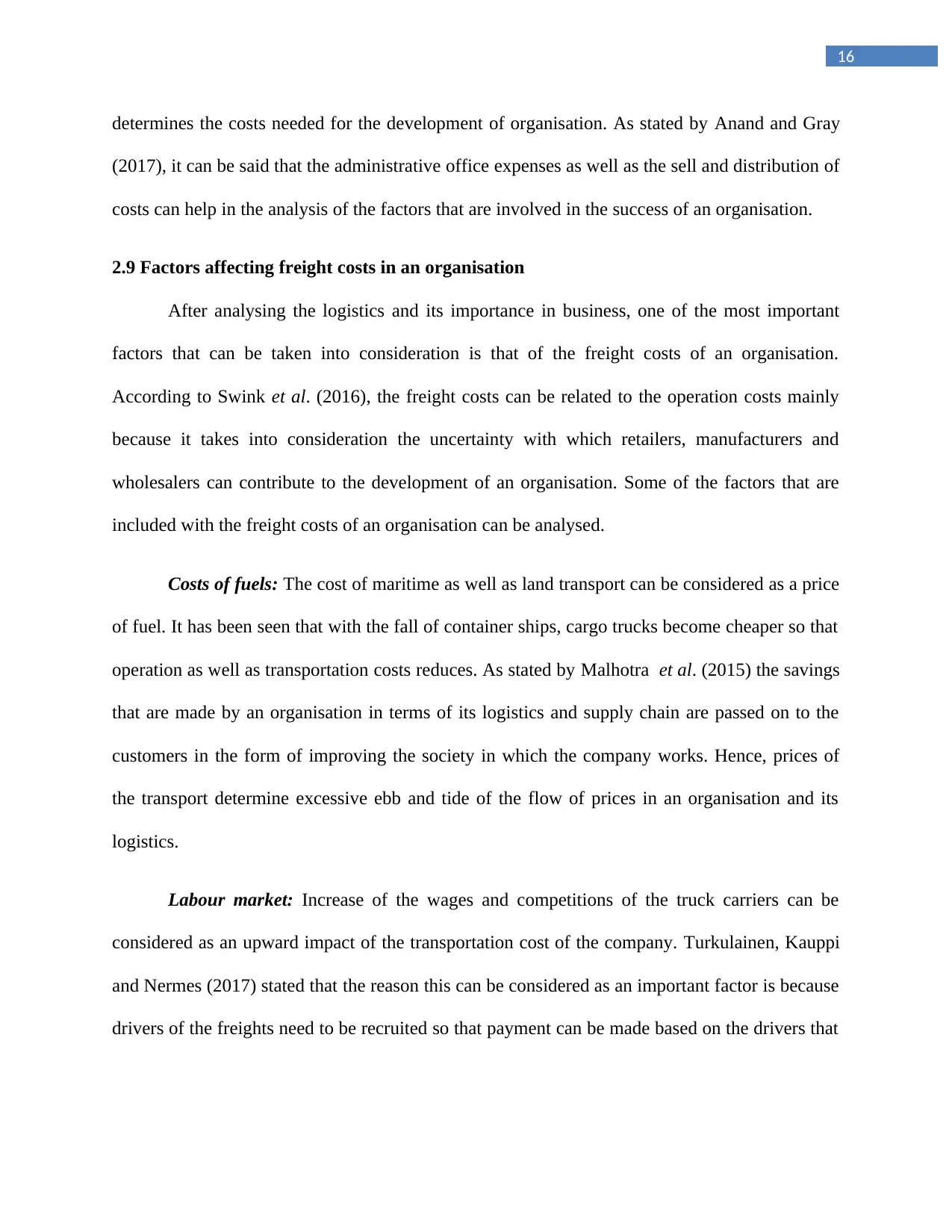
16
determines the costs needed for the development of organisation. As stated by Anand and Gray
(2017), it can be said that the administrative office expenses as well as the sell and distribution of
costs can help in the analysis of the factors that are involved in the success of an organisation.
2.9 Factors affecting freight costs in an organisation
After analysing the logistics and its importance in business, one of the most important
factors that can be taken into consideration is that of the freight costs of an organisation.
According to Swink et al. (2016), the freight costs can be related to the operation costs mainly
because it takes into consideration the uncertainty with which retailers, manufacturers and
wholesalers can contribute to the development of an organisation. Some of the factors that are
included with the freight costs of an organisation can be analysed.
Costs of fuels: The cost of maritime as well as land transport can be considered as a price
of fuel. It has been seen that with the fall of container ships, cargo trucks become cheaper so that
operation as well as transportation costs reduces. As stated by Malhotra et al. (2015) the savings
that are made by an organisation in terms of its logistics and supply chain are passed on to the
customers in the form of improving the society in which the company works. Hence, prices of
the transport determine excessive ebb and tide of the flow of prices in an organisation and its
logistics.
Labour market: Increase of the wages and competitions of the truck carriers can be
considered as an upward impact of the transportation cost of the company. Turkulainen, Kauppi
and Nermes (2017) stated that the reason this can be considered as an important factor is because
drivers of the freights need to be recruited so that payment can be made based on the drivers that
determines the costs needed for the development of organisation. As stated by Anand and Gray
(2017), it can be said that the administrative office expenses as well as the sell and distribution of
costs can help in the analysis of the factors that are involved in the success of an organisation.
2.9 Factors affecting freight costs in an organisation
After analysing the logistics and its importance in business, one of the most important
factors that can be taken into consideration is that of the freight costs of an organisation.
According to Swink et al. (2016), the freight costs can be related to the operation costs mainly
because it takes into consideration the uncertainty with which retailers, manufacturers and
wholesalers can contribute to the development of an organisation. Some of the factors that are
included with the freight costs of an organisation can be analysed.
Costs of fuels: The cost of maritime as well as land transport can be considered as a price
of fuel. It has been seen that with the fall of container ships, cargo trucks become cheaper so that
operation as well as transportation costs reduces. As stated by Malhotra et al. (2015) the savings
that are made by an organisation in terms of its logistics and supply chain are passed on to the
customers in the form of improving the society in which the company works. Hence, prices of
the transport determine excessive ebb and tide of the flow of prices in an organisation and its
logistics.
Labour market: Increase of the wages and competitions of the truck carriers can be
considered as an upward impact of the transportation cost of the company. Turkulainen, Kauppi
and Nermes (2017) stated that the reason this can be considered as an important factor is because
drivers of the freights need to be recruited so that payment can be made based on the drivers that

17
are available for the company. In this regard, it can be said that for logistics companies extra cost
of labour in the form of drivers or carriers of the freight need to be considered as budget.
Loyalty of the customers: This can be considered as a recurring factor for any
organisation as the loyalty of the customers is important for the survival of a business. In the case
of the logistics companies, the loyalty of the companies may include the business-to-business
market as well as the business-to-customer market that can provide extra profit for an
organisation (Roth et al. 2016). In this case, it can be said that without loyalty of the customers it
can be difficult for freight operations to continue with the effective functioning in the market.
Government regulations: The Government regulations play an important role for the
development of an organisation. This is because the rules related to the transportation of goods
using heavy vehicles can be limited (Thomé, Scavarda and Scavarda 2016). This can provide
organisations with an issue of earning profit. Hence, based on the limitations of the Government
organisations need to maintain the transportation of goods from one place to another.
2.10 Importance of operating costs
The analysis of the concept of operating costs help in understanding the importance it has
on the development of a business. It has been seen by Holweg et al. (2018) that an operating
expense can be considered as an item that can help in help in the continuous generation of
income for an organisation. Some of the examples of the operating costs include the property
taxes, cost or repairs and maintenance as well as care and insurance that need to be undertaken
by an organisation. This provides an analysis of the factors that help in understanding the
expenses that are incurred by an organisation. Expenses are one of the operational charges that
are available for the company. In this regard, it can be said that for logistics companies extra cost
of labour in the form of drivers or carriers of the freight need to be considered as budget.
Loyalty of the customers: This can be considered as a recurring factor for any
organisation as the loyalty of the customers is important for the survival of a business. In the case
of the logistics companies, the loyalty of the companies may include the business-to-business
market as well as the business-to-customer market that can provide extra profit for an
organisation (Roth et al. 2016). In this case, it can be said that without loyalty of the customers it
can be difficult for freight operations to continue with the effective functioning in the market.
Government regulations: The Government regulations play an important role for the
development of an organisation. This is because the rules related to the transportation of goods
using heavy vehicles can be limited (Thomé, Scavarda and Scavarda 2016). This can provide
organisations with an issue of earning profit. Hence, based on the limitations of the Government
organisations need to maintain the transportation of goods from one place to another.
2.10 Importance of operating costs
The analysis of the concept of operating costs help in understanding the importance it has
on the development of a business. It has been seen by Holweg et al. (2018) that an operating
expense can be considered as an item that can help in help in the continuous generation of
income for an organisation. Some of the examples of the operating costs include the property
taxes, cost or repairs and maintenance as well as care and insurance that need to be undertaken
by an organisation. This provides an analysis of the factors that help in understanding the
expenses that are incurred by an organisation. Expenses are one of the operational charges that
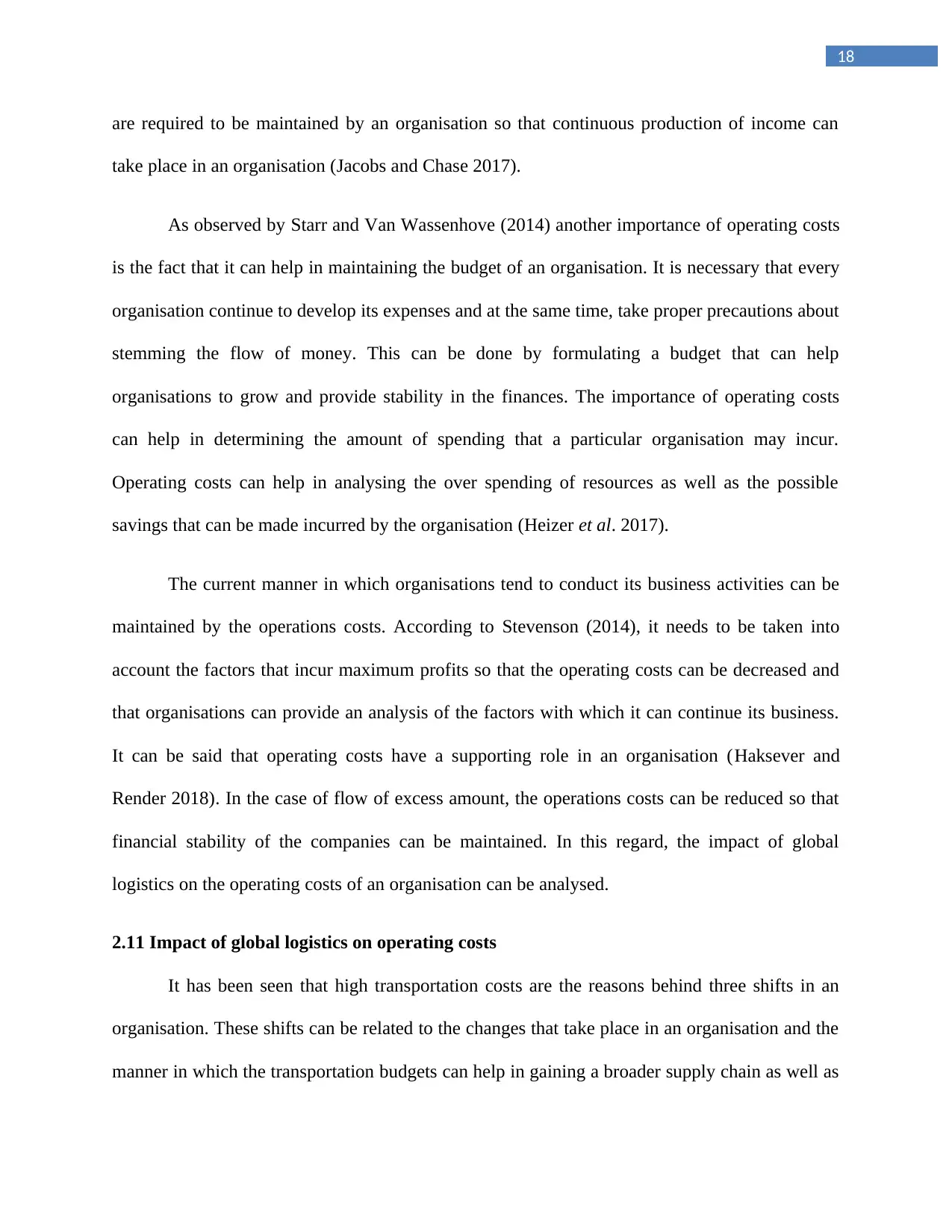
18
are required to be maintained by an organisation so that continuous production of income can
take place in an organisation (Jacobs and Chase 2017).
As observed by Starr and Van Wassenhove (2014) another importance of operating costs
is the fact that it can help in maintaining the budget of an organisation. It is necessary that every
organisation continue to develop its expenses and at the same time, take proper precautions about
stemming the flow of money. This can be done by formulating a budget that can help
organisations to grow and provide stability in the finances. The importance of operating costs
can help in determining the amount of spending that a particular organisation may incur.
Operating costs can help in analysing the over spending of resources as well as the possible
savings that can be made incurred by the organisation (Heizer et al. 2017).
The current manner in which organisations tend to conduct its business activities can be
maintained by the operations costs. According to Stevenson (2014), it needs to be taken into
account the factors that incur maximum profits so that the operating costs can be decreased and
that organisations can provide an analysis of the factors with which it can continue its business.
It can be said that operating costs have a supporting role in an organisation (Haksever and
Render 2018). In the case of flow of excess amount, the operations costs can be reduced so that
financial stability of the companies can be maintained. In this regard, the impact of global
logistics on the operating costs of an organisation can be analysed.
2.11 Impact of global logistics on operating costs
It has been seen that high transportation costs are the reasons behind three shifts in an
organisation. These shifts can be related to the changes that take place in an organisation and the
manner in which the transportation budgets can help in gaining a broader supply chain as well as
are required to be maintained by an organisation so that continuous production of income can
take place in an organisation (Jacobs and Chase 2017).
As observed by Starr and Van Wassenhove (2014) another importance of operating costs
is the fact that it can help in maintaining the budget of an organisation. It is necessary that every
organisation continue to develop its expenses and at the same time, take proper precautions about
stemming the flow of money. This can be done by formulating a budget that can help
organisations to grow and provide stability in the finances. The importance of operating costs
can help in determining the amount of spending that a particular organisation may incur.
Operating costs can help in analysing the over spending of resources as well as the possible
savings that can be made incurred by the organisation (Heizer et al. 2017).
The current manner in which organisations tend to conduct its business activities can be
maintained by the operations costs. According to Stevenson (2014), it needs to be taken into
account the factors that incur maximum profits so that the operating costs can be decreased and
that organisations can provide an analysis of the factors with which it can continue its business.
It can be said that operating costs have a supporting role in an organisation (Haksever and
Render 2018). In the case of flow of excess amount, the operations costs can be reduced so that
financial stability of the companies can be maintained. In this regard, the impact of global
logistics on the operating costs of an organisation can be analysed.
2.11 Impact of global logistics on operating costs
It has been seen that high transportation costs are the reasons behind three shifts in an
organisation. These shifts can be related to the changes that take place in an organisation and the
manner in which the transportation budgets can help in gaining a broader supply chain as well as
Paraphrase This Document
Need a fresh take? Get an instant paraphrase of this document with our AI Paraphraser
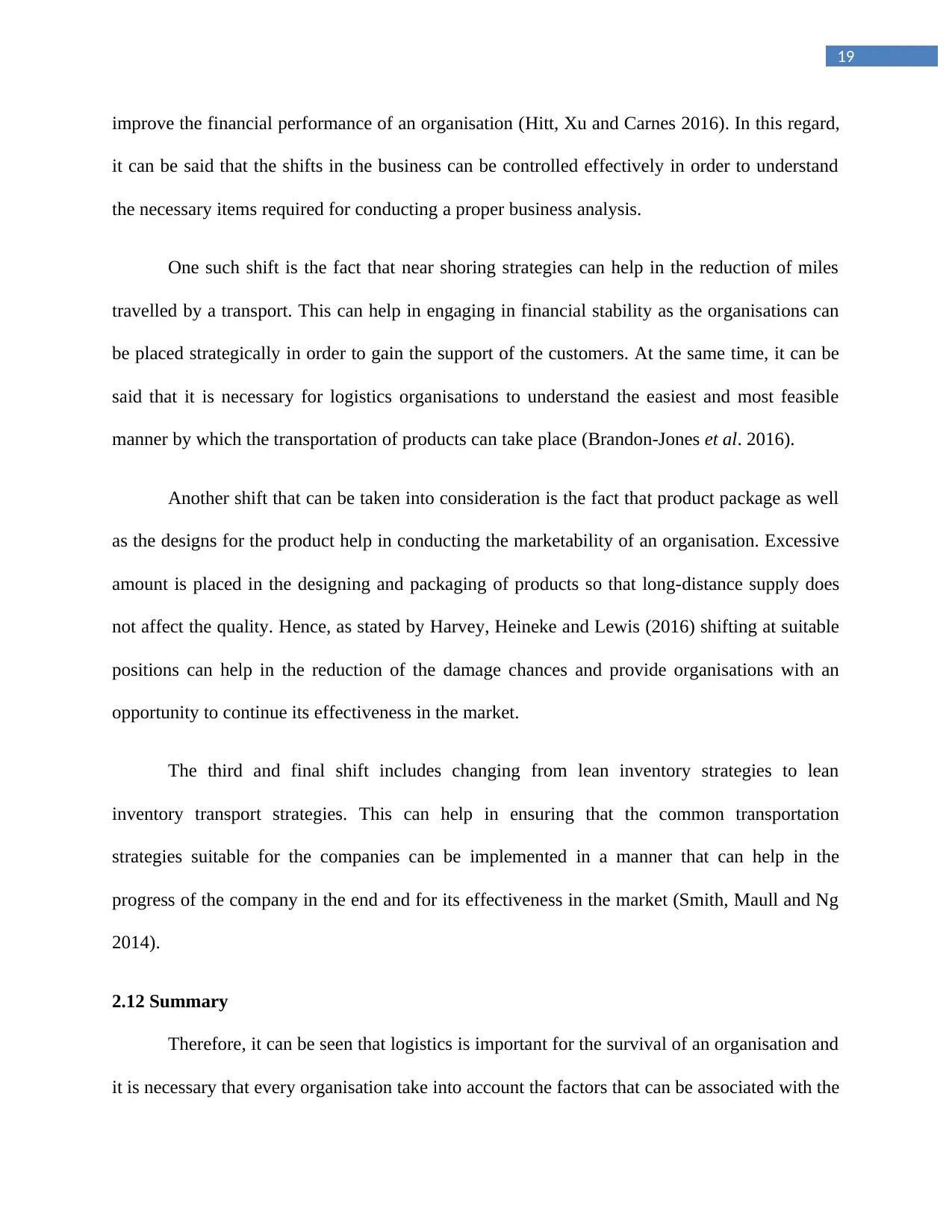
19
improve the financial performance of an organisation (Hitt, Xu and Carnes 2016). In this regard,
it can be said that the shifts in the business can be controlled effectively in order to understand
the necessary items required for conducting a proper business analysis.
One such shift is the fact that near shoring strategies can help in the reduction of miles
travelled by a transport. This can help in engaging in financial stability as the organisations can
be placed strategically in order to gain the support of the customers. At the same time, it can be
said that it is necessary for logistics organisations to understand the easiest and most feasible
manner by which the transportation of products can take place (Brandon-Jones et al. 2016).
Another shift that can be taken into consideration is the fact that product package as well
as the designs for the product help in conducting the marketability of an organisation. Excessive
amount is placed in the designing and packaging of products so that long-distance supply does
not affect the quality. Hence, as stated by Harvey, Heineke and Lewis (2016) shifting at suitable
positions can help in the reduction of the damage chances and provide organisations with an
opportunity to continue its effectiveness in the market.
The third and final shift includes changing from lean inventory strategies to lean
inventory transport strategies. This can help in ensuring that the common transportation
strategies suitable for the companies can be implemented in a manner that can help in the
progress of the company in the end and for its effectiveness in the market (Smith, Maull and Ng
2014).
2.12 Summary
Therefore, it can be seen that logistics is important for the survival of an organisation and
it is necessary that every organisation take into account the factors that can be associated with the
improve the financial performance of an organisation (Hitt, Xu and Carnes 2016). In this regard,
it can be said that the shifts in the business can be controlled effectively in order to understand
the necessary items required for conducting a proper business analysis.
One such shift is the fact that near shoring strategies can help in the reduction of miles
travelled by a transport. This can help in engaging in financial stability as the organisations can
be placed strategically in order to gain the support of the customers. At the same time, it can be
said that it is necessary for logistics organisations to understand the easiest and most feasible
manner by which the transportation of products can take place (Brandon-Jones et al. 2016).
Another shift that can be taken into consideration is the fact that product package as well
as the designs for the product help in conducting the marketability of an organisation. Excessive
amount is placed in the designing and packaging of products so that long-distance supply does
not affect the quality. Hence, as stated by Harvey, Heineke and Lewis (2016) shifting at suitable
positions can help in the reduction of the damage chances and provide organisations with an
opportunity to continue its effectiveness in the market.
The third and final shift includes changing from lean inventory strategies to lean
inventory transport strategies. This can help in ensuring that the common transportation
strategies suitable for the companies can be implemented in a manner that can help in the
progress of the company in the end and for its effectiveness in the market (Smith, Maull and Ng
2014).
2.12 Summary
Therefore, it can be seen that logistics is important for the survival of an organisation and
it is necessary that every organisation take into account the factors that can be associated with the
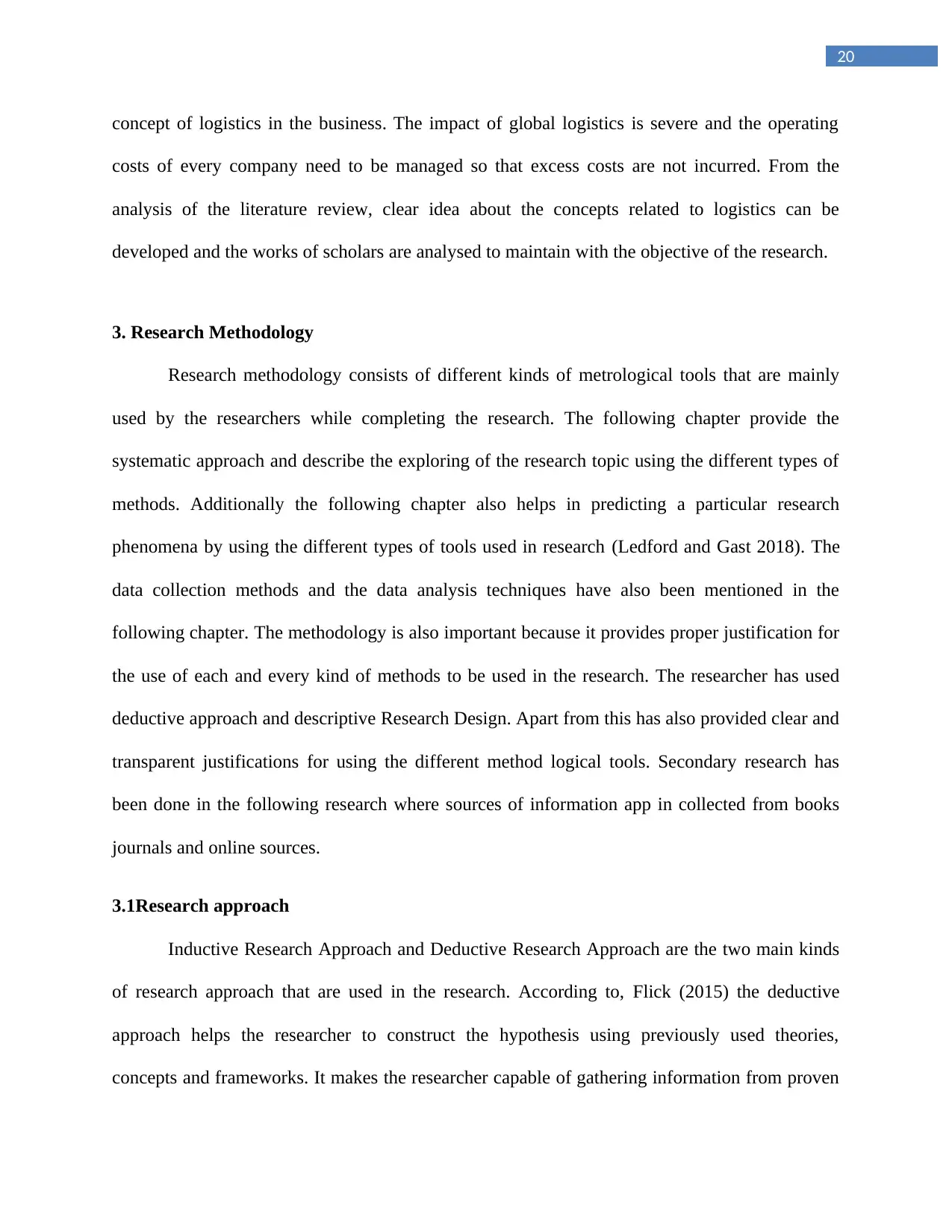
20
concept of logistics in the business. The impact of global logistics is severe and the operating
costs of every company need to be managed so that excess costs are not incurred. From the
analysis of the literature review, clear idea about the concepts related to logistics can be
developed and the works of scholars are analysed to maintain with the objective of the research.
3. Research Methodology
Research methodology consists of different kinds of metrological tools that are mainly
used by the researchers while completing the research. The following chapter provide the
systematic approach and describe the exploring of the research topic using the different types of
methods. Additionally the following chapter also helps in predicting a particular research
phenomena by using the different types of tools used in research (Ledford and Gast 2018). The
data collection methods and the data analysis techniques have also been mentioned in the
following chapter. The methodology is also important because it provides proper justification for
the use of each and every kind of methods to be used in the research. The researcher has used
deductive approach and descriptive Research Design. Apart from this has also provided clear and
transparent justifications for using the different method logical tools. Secondary research has
been done in the following research where sources of information app in collected from books
journals and online sources.
3.1Research approach
Inductive Research Approach and Deductive Research Approach are the two main kinds
of research approach that are used in the research. According to, Flick (2015) the deductive
approach helps the researcher to construct the hypothesis using previously used theories,
concepts and frameworks. It makes the researcher capable of gathering information from proven
concept of logistics in the business. The impact of global logistics is severe and the operating
costs of every company need to be managed so that excess costs are not incurred. From the
analysis of the literature review, clear idea about the concepts related to logistics can be
developed and the works of scholars are analysed to maintain with the objective of the research.
3. Research Methodology
Research methodology consists of different kinds of metrological tools that are mainly
used by the researchers while completing the research. The following chapter provide the
systematic approach and describe the exploring of the research topic using the different types of
methods. Additionally the following chapter also helps in predicting a particular research
phenomena by using the different types of tools used in research (Ledford and Gast 2018). The
data collection methods and the data analysis techniques have also been mentioned in the
following chapter. The methodology is also important because it provides proper justification for
the use of each and every kind of methods to be used in the research. The researcher has used
deductive approach and descriptive Research Design. Apart from this has also provided clear and
transparent justifications for using the different method logical tools. Secondary research has
been done in the following research where sources of information app in collected from books
journals and online sources.
3.1Research approach
Inductive Research Approach and Deductive Research Approach are the two main kinds
of research approach that are used in the research. According to, Flick (2015) the deductive
approach helps the researcher to construct the hypothesis using previously used theories,
concepts and frameworks. It makes the researcher capable of gathering information from proven
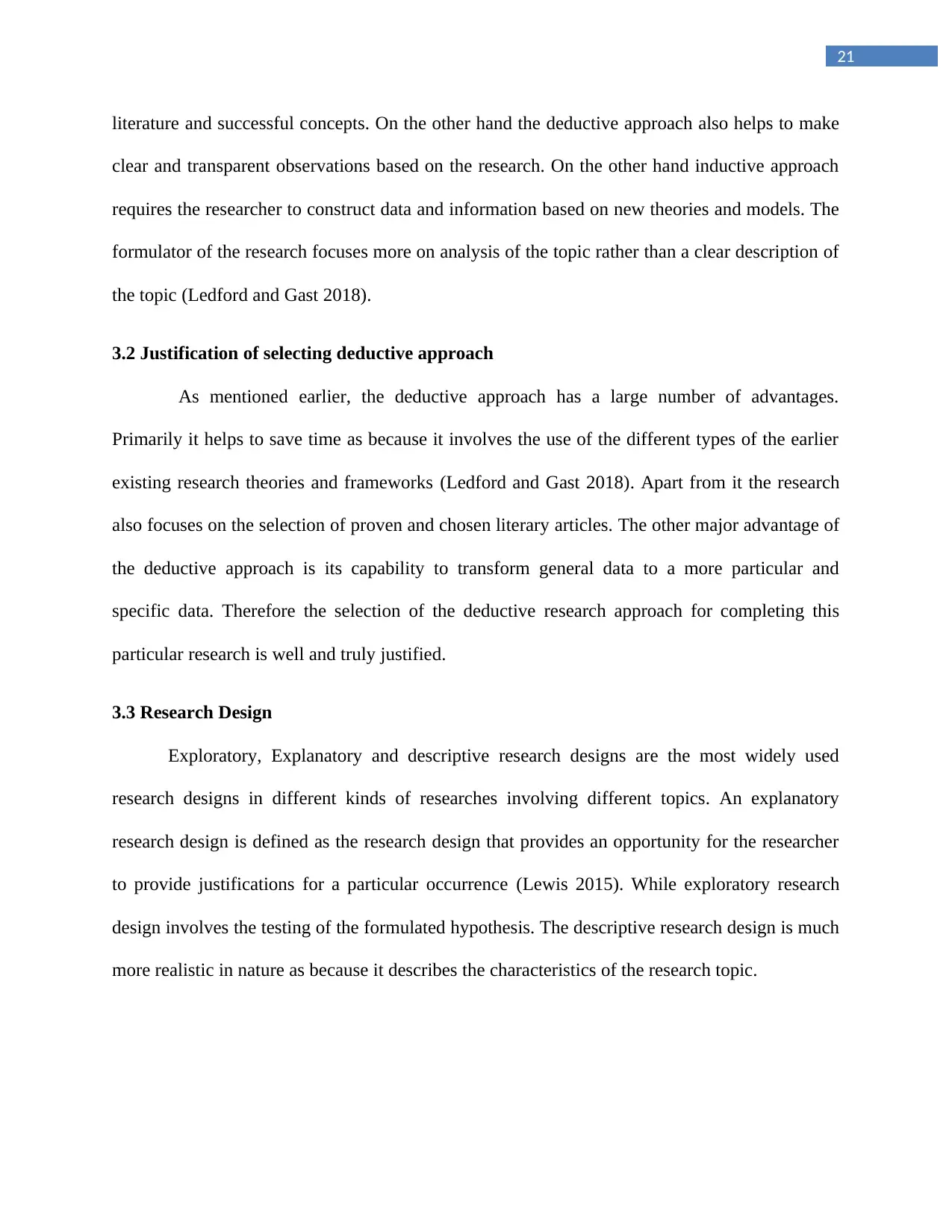
21
literature and successful concepts. On the other hand the deductive approach also helps to make
clear and transparent observations based on the research. On the other hand inductive approach
requires the researcher to construct data and information based on new theories and models. The
formulator of the research focuses more on analysis of the topic rather than a clear description of
the topic (Ledford and Gast 2018).
3.2 Justification of selecting deductive approach
As mentioned earlier, the deductive approach has a large number of advantages.
Primarily it helps to save time as because it involves the use of the different types of the earlier
existing research theories and frameworks (Ledford and Gast 2018). Apart from it the research
also focuses on the selection of proven and chosen literary articles. The other major advantage of
the deductive approach is its capability to transform general data to a more particular and
specific data. Therefore the selection of the deductive research approach for completing this
particular research is well and truly justified.
3.3 Research Design
Exploratory, Explanatory and descriptive research designs are the most widely used
research designs in different kinds of researches involving different topics. An explanatory
research design is defined as the research design that provides an opportunity for the researcher
to provide justifications for a particular occurrence (Lewis 2015). While exploratory research
design involves the testing of the formulated hypothesis. The descriptive research design is much
more realistic in nature as because it describes the characteristics of the research topic.
literature and successful concepts. On the other hand the deductive approach also helps to make
clear and transparent observations based on the research. On the other hand inductive approach
requires the researcher to construct data and information based on new theories and models. The
formulator of the research focuses more on analysis of the topic rather than a clear description of
the topic (Ledford and Gast 2018).
3.2 Justification of selecting deductive approach
As mentioned earlier, the deductive approach has a large number of advantages.
Primarily it helps to save time as because it involves the use of the different types of the earlier
existing research theories and frameworks (Ledford and Gast 2018). Apart from it the research
also focuses on the selection of proven and chosen literary articles. The other major advantage of
the deductive approach is its capability to transform general data to a more particular and
specific data. Therefore the selection of the deductive research approach for completing this
particular research is well and truly justified.
3.3 Research Design
Exploratory, Explanatory and descriptive research designs are the most widely used
research designs in different kinds of researches involving different topics. An explanatory
research design is defined as the research design that provides an opportunity for the researcher
to provide justifications for a particular occurrence (Lewis 2015). While exploratory research
design involves the testing of the formulated hypothesis. The descriptive research design is much
more realistic in nature as because it describes the characteristics of the research topic.
Secure Best Marks with AI Grader
Need help grading? Try our AI Grader for instant feedback on your assignments.
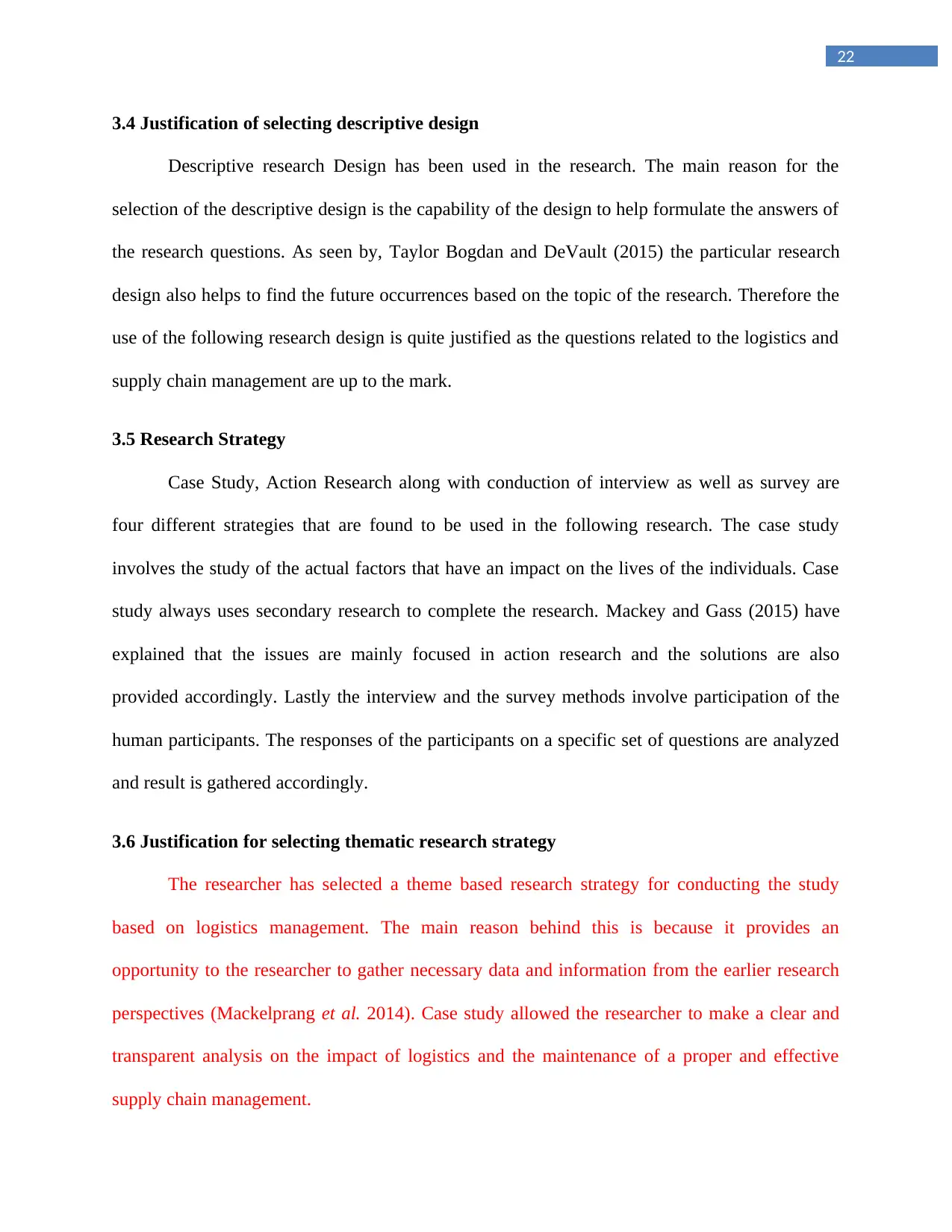
22
3.4 Justification of selecting descriptive design
Descriptive research Design has been used in the research. The main reason for the
selection of the descriptive design is the capability of the design to help formulate the answers of
the research questions. As seen by, Taylor Bogdan and DeVault (2015) the particular research
design also helps to find the future occurrences based on the topic of the research. Therefore the
use of the following research design is quite justified as the questions related to the logistics and
supply chain management are up to the mark.
3.5 Research Strategy
Case Study, Action Research along with conduction of interview as well as survey are
four different strategies that are found to be used in the following research. The case study
involves the study of the actual factors that have an impact on the lives of the individuals. Case
study always uses secondary research to complete the research. Mackey and Gass (2015) have
explained that the issues are mainly focused in action research and the solutions are also
provided accordingly. Lastly the interview and the survey methods involve participation of the
human participants. The responses of the participants on a specific set of questions are analyzed
and result is gathered accordingly.
3.6 Justification for selecting thematic research strategy
The researcher has selected a theme based research strategy for conducting the study
based on logistics management. The main reason behind this is because it provides an
opportunity to the researcher to gather necessary data and information from the earlier research
perspectives (Mackelprang et al. 2014). Case study allowed the researcher to make a clear and
transparent analysis on the impact of logistics and the maintenance of a proper and effective
supply chain management.
3.4 Justification of selecting descriptive design
Descriptive research Design has been used in the research. The main reason for the
selection of the descriptive design is the capability of the design to help formulate the answers of
the research questions. As seen by, Taylor Bogdan and DeVault (2015) the particular research
design also helps to find the future occurrences based on the topic of the research. Therefore the
use of the following research design is quite justified as the questions related to the logistics and
supply chain management are up to the mark.
3.5 Research Strategy
Case Study, Action Research along with conduction of interview as well as survey are
four different strategies that are found to be used in the following research. The case study
involves the study of the actual factors that have an impact on the lives of the individuals. Case
study always uses secondary research to complete the research. Mackey and Gass (2015) have
explained that the issues are mainly focused in action research and the solutions are also
provided accordingly. Lastly the interview and the survey methods involve participation of the
human participants. The responses of the participants on a specific set of questions are analyzed
and result is gathered accordingly.
3.6 Justification for selecting thematic research strategy
The researcher has selected a theme based research strategy for conducting the study
based on logistics management. The main reason behind this is because it provides an
opportunity to the researcher to gather necessary data and information from the earlier research
perspectives (Mackelprang et al. 2014). Case study allowed the researcher to make a clear and
transparent analysis on the impact of logistics and the maintenance of a proper and effective
supply chain management.
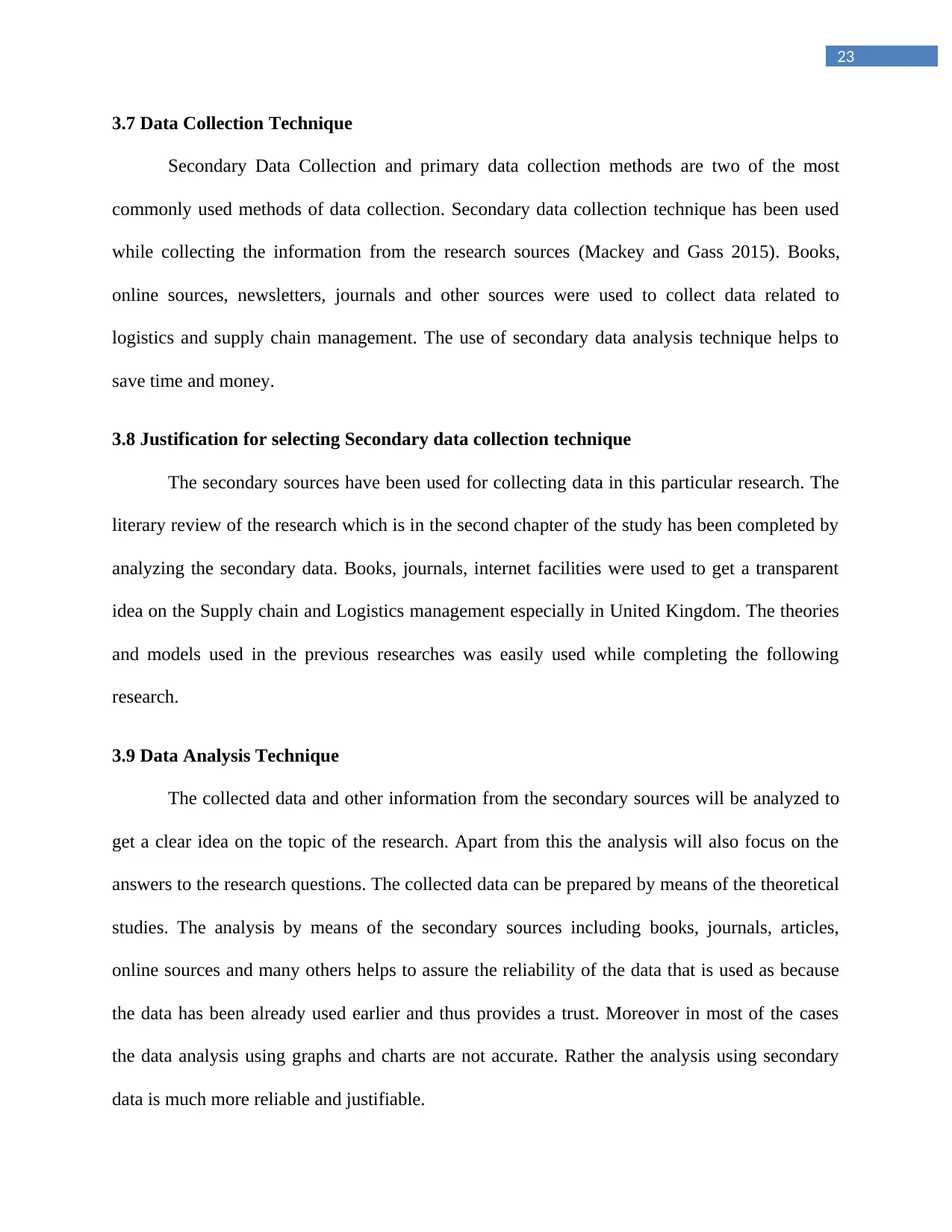
23
3.7 Data Collection Technique
Secondary Data Collection and primary data collection methods are two of the most
commonly used methods of data collection. Secondary data collection technique has been used
while collecting the information from the research sources (Mackey and Gass 2015). Books,
online sources, newsletters, journals and other sources were used to collect data related to
logistics and supply chain management. The use of secondary data analysis technique helps to
save time and money.
3.8 Justification for selecting Secondary data collection technique
The secondary sources have been used for collecting data in this particular research. The
literary review of the research which is in the second chapter of the study has been completed by
analyzing the secondary data. Books, journals, internet facilities were used to get a transparent
idea on the Supply chain and Logistics management especially in United Kingdom. The theories
and models used in the previous researches was easily used while completing the following
research.
3.9 Data Analysis Technique
The collected data and other information from the secondary sources will be analyzed to
get a clear idea on the topic of the research. Apart from this the analysis will also focus on the
answers to the research questions. The collected data can be prepared by means of the theoretical
studies. The analysis by means of the secondary sources including books, journals, articles,
online sources and many others helps to assure the reliability of the data that is used as because
the data has been already used earlier and thus provides a trust. Moreover in most of the cases
the data analysis using graphs and charts are not accurate. Rather the analysis using secondary
data is much more reliable and justifiable.
3.7 Data Collection Technique
Secondary Data Collection and primary data collection methods are two of the most
commonly used methods of data collection. Secondary data collection technique has been used
while collecting the information from the research sources (Mackey and Gass 2015). Books,
online sources, newsletters, journals and other sources were used to collect data related to
logistics and supply chain management. The use of secondary data analysis technique helps to
save time and money.
3.8 Justification for selecting Secondary data collection technique
The secondary sources have been used for collecting data in this particular research. The
literary review of the research which is in the second chapter of the study has been completed by
analyzing the secondary data. Books, journals, internet facilities were used to get a transparent
idea on the Supply chain and Logistics management especially in United Kingdom. The theories
and models used in the previous researches was easily used while completing the following
research.
3.9 Data Analysis Technique
The collected data and other information from the secondary sources will be analyzed to
get a clear idea on the topic of the research. Apart from this the analysis will also focus on the
answers to the research questions. The collected data can be prepared by means of the theoretical
studies. The analysis by means of the secondary sources including books, journals, articles,
online sources and many others helps to assure the reliability of the data that is used as because
the data has been already used earlier and thus provides a trust. Moreover in most of the cases
the data analysis using graphs and charts are not accurate. Rather the analysis using secondary
data is much more reliable and justifiable.
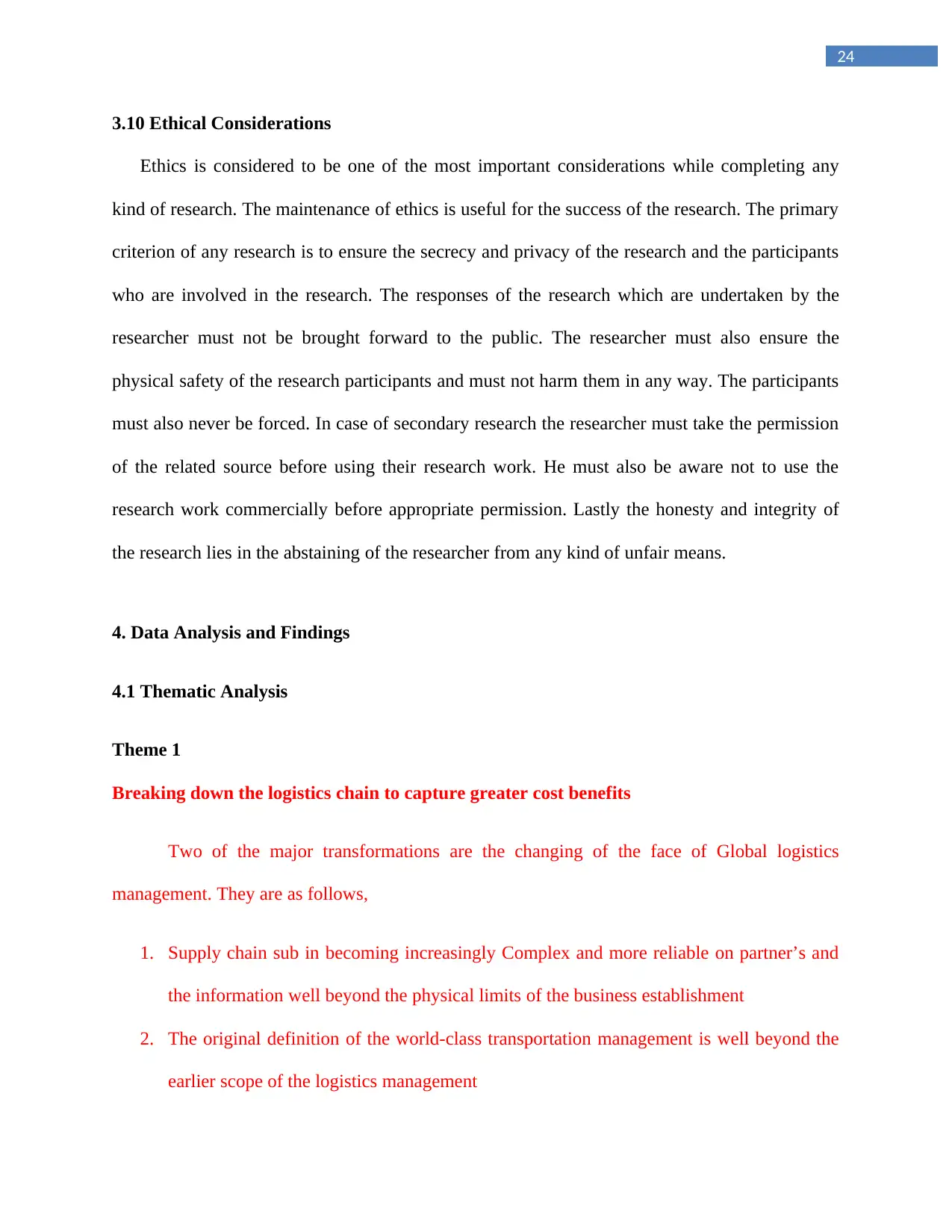
24
3.10 Ethical Considerations
Ethics is considered to be one of the most important considerations while completing any
kind of research. The maintenance of ethics is useful for the success of the research. The primary
criterion of any research is to ensure the secrecy and privacy of the research and the participants
who are involved in the research. The responses of the research which are undertaken by the
researcher must not be brought forward to the public. The researcher must also ensure the
physical safety of the research participants and must not harm them in any way. The participants
must also never be forced. In case of secondary research the researcher must take the permission
of the related source before using their research work. He must also be aware not to use the
research work commercially before appropriate permission. Lastly the honesty and integrity of
the research lies in the abstaining of the researcher from any kind of unfair means.
4. Data Analysis and Findings
4.1 Thematic Analysis
Theme 1
Breaking down the logistics chain to capture greater cost benefits
Two of the major transformations are the changing of the face of Global logistics
management. They are as follows,
1. Supply chain sub in becoming increasingly Complex and more reliable on partner’s and
the information well beyond the physical limits of the business establishment
2. The original definition of the world-class transportation management is well beyond the
earlier scope of the logistics management
3.10 Ethical Considerations
Ethics is considered to be one of the most important considerations while completing any
kind of research. The maintenance of ethics is useful for the success of the research. The primary
criterion of any research is to ensure the secrecy and privacy of the research and the participants
who are involved in the research. The responses of the research which are undertaken by the
researcher must not be brought forward to the public. The researcher must also ensure the
physical safety of the research participants and must not harm them in any way. The participants
must also never be forced. In case of secondary research the researcher must take the permission
of the related source before using their research work. He must also be aware not to use the
research work commercially before appropriate permission. Lastly the honesty and integrity of
the research lies in the abstaining of the researcher from any kind of unfair means.
4. Data Analysis and Findings
4.1 Thematic Analysis
Theme 1
Breaking down the logistics chain to capture greater cost benefits
Two of the major transformations are the changing of the face of Global logistics
management. They are as follows,
1. Supply chain sub in becoming increasingly Complex and more reliable on partner’s and
the information well beyond the physical limits of the business establishment
2. The original definition of the world-class transportation management is well beyond the
earlier scope of the logistics management
Paraphrase This Document
Need a fresh take? Get an instant paraphrase of this document with our AI Paraphraser
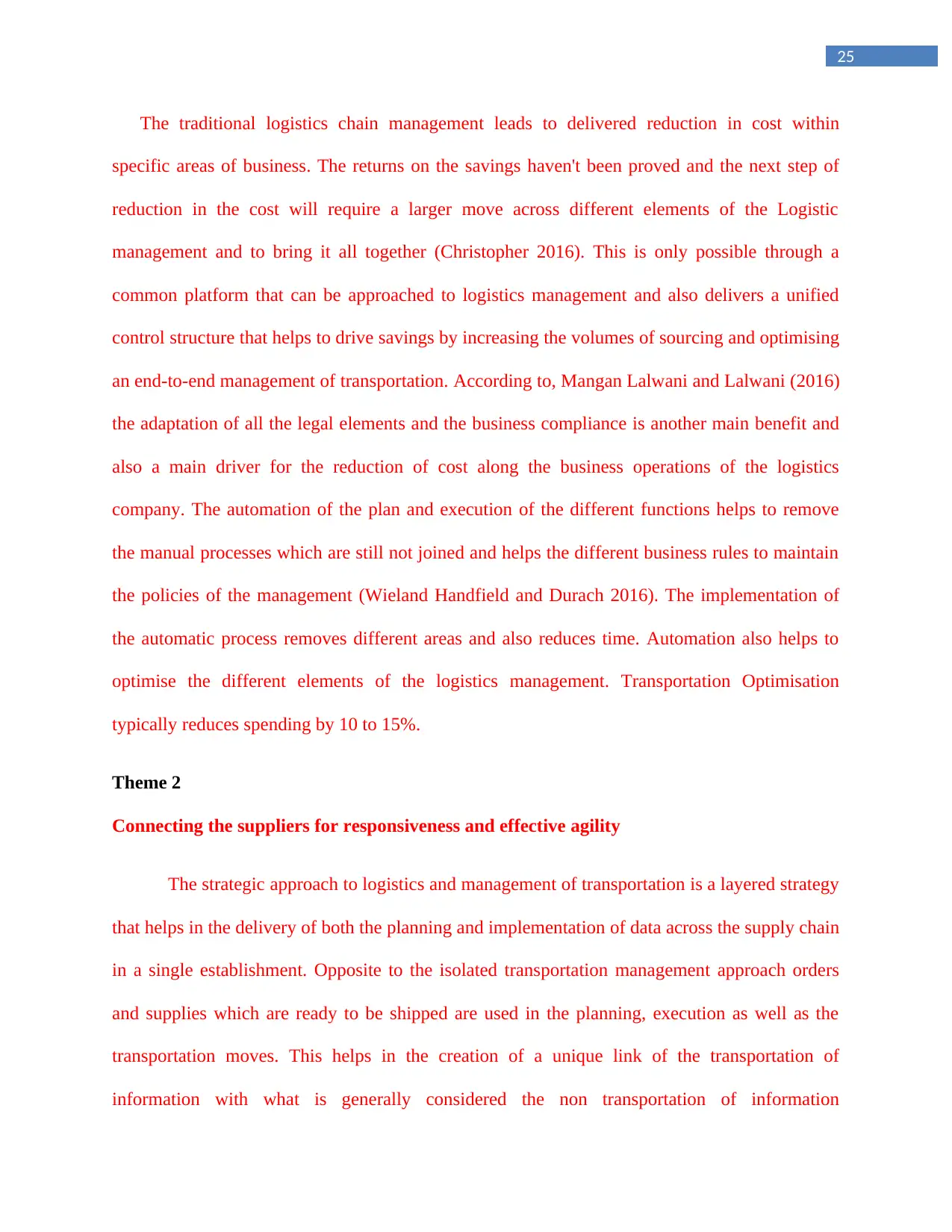
25
The traditional logistics chain management leads to delivered reduction in cost within
specific areas of business. The returns on the savings haven't been proved and the next step of
reduction in the cost will require a larger move across different elements of the Logistic
management and to bring it all together (Christopher 2016). This is only possible through a
common platform that can be approached to logistics management and also delivers a unified
control structure that helps to drive savings by increasing the volumes of sourcing and optimising
an end-to-end management of transportation. According to, Mangan Lalwani and Lalwani (2016)
the adaptation of all the legal elements and the business compliance is another main benefit and
also a main driver for the reduction of cost along the business operations of the logistics
company. The automation of the plan and execution of the different functions helps to remove
the manual processes which are still not joined and helps the different business rules to maintain
the policies of the management (Wieland Handfield and Durach 2016). The implementation of
the automatic process removes different areas and also reduces time. Automation also helps to
optimise the different elements of the logistics management. Transportation Optimisation
typically reduces spending by 10 to 15%.
Theme 2
Connecting the suppliers for responsiveness and effective agility
The strategic approach to logistics and management of transportation is a layered strategy
that helps in the delivery of both the planning and implementation of data across the supply chain
in a single establishment. Opposite to the isolated transportation management approach orders
and supplies which are ready to be shipped are used in the planning, execution as well as the
transportation moves. This helps in the creation of a unique link of the transportation of
information with what is generally considered the non transportation of information
The traditional logistics chain management leads to delivered reduction in cost within
specific areas of business. The returns on the savings haven't been proved and the next step of
reduction in the cost will require a larger move across different elements of the Logistic
management and to bring it all together (Christopher 2016). This is only possible through a
common platform that can be approached to logistics management and also delivers a unified
control structure that helps to drive savings by increasing the volumes of sourcing and optimising
an end-to-end management of transportation. According to, Mangan Lalwani and Lalwani (2016)
the adaptation of all the legal elements and the business compliance is another main benefit and
also a main driver for the reduction of cost along the business operations of the logistics
company. The automation of the plan and execution of the different functions helps to remove
the manual processes which are still not joined and helps the different business rules to maintain
the policies of the management (Wieland Handfield and Durach 2016). The implementation of
the automatic process removes different areas and also reduces time. Automation also helps to
optimise the different elements of the logistics management. Transportation Optimisation
typically reduces spending by 10 to 15%.
Theme 2
Connecting the suppliers for responsiveness and effective agility
The strategic approach to logistics and management of transportation is a layered strategy
that helps in the delivery of both the planning and implementation of data across the supply chain
in a single establishment. Opposite to the isolated transportation management approach orders
and supplies which are ready to be shipped are used in the planning, execution as well as the
transportation moves. This helps in the creation of a unique link of the transportation of
information with what is generally considered the non transportation of information
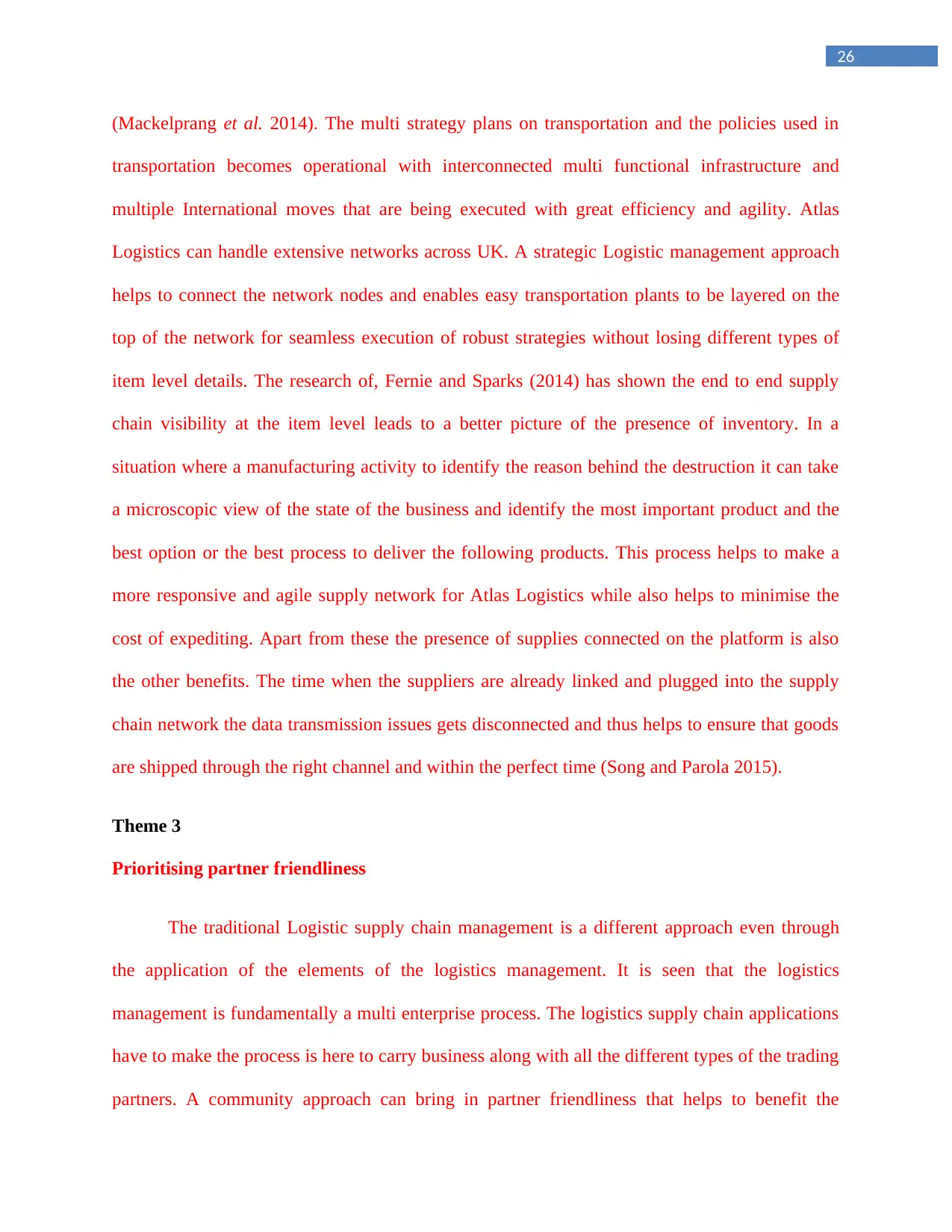
26
(Mackelprang et al. 2014). The multi strategy plans on transportation and the policies used in
transportation becomes operational with interconnected multi functional infrastructure and
multiple International moves that are being executed with great efficiency and agility. Atlas
Logistics can handle extensive networks across UK. A strategic Logistic management approach
helps to connect the network nodes and enables easy transportation plants to be layered on the
top of the network for seamless execution of robust strategies without losing different types of
item level details. The research of, Fernie and Sparks (2014) has shown the end to end supply
chain visibility at the item level leads to a better picture of the presence of inventory. In a
situation where a manufacturing activity to identify the reason behind the destruction it can take
a microscopic view of the state of the business and identify the most important product and the
best option or the best process to deliver the following products. This process helps to make a
more responsive and agile supply network for Atlas Logistics while also helps to minimise the
cost of expediting. Apart from these the presence of supplies connected on the platform is also
the other benefits. The time when the suppliers are already linked and plugged into the supply
chain network the data transmission issues gets disconnected and thus helps to ensure that goods
are shipped through the right channel and within the perfect time (Song and Parola 2015).
Theme 3
Prioritising partner friendliness
The traditional Logistic supply chain management is a different approach even through
the application of the elements of the logistics management. It is seen that the logistics
management is fundamentally a multi enterprise process. The logistics supply chain applications
have to make the process is here to carry business along with all the different types of the trading
partners. A community approach can bring in partner friendliness that helps to benefit the
(Mackelprang et al. 2014). The multi strategy plans on transportation and the policies used in
transportation becomes operational with interconnected multi functional infrastructure and
multiple International moves that are being executed with great efficiency and agility. Atlas
Logistics can handle extensive networks across UK. A strategic Logistic management approach
helps to connect the network nodes and enables easy transportation plants to be layered on the
top of the network for seamless execution of robust strategies without losing different types of
item level details. The research of, Fernie and Sparks (2014) has shown the end to end supply
chain visibility at the item level leads to a better picture of the presence of inventory. In a
situation where a manufacturing activity to identify the reason behind the destruction it can take
a microscopic view of the state of the business and identify the most important product and the
best option or the best process to deliver the following products. This process helps to make a
more responsive and agile supply network for Atlas Logistics while also helps to minimise the
cost of expediting. Apart from these the presence of supplies connected on the platform is also
the other benefits. The time when the suppliers are already linked and plugged into the supply
chain network the data transmission issues gets disconnected and thus helps to ensure that goods
are shipped through the right channel and within the perfect time (Song and Parola 2015).
Theme 3
Prioritising partner friendliness
The traditional Logistic supply chain management is a different approach even through
the application of the elements of the logistics management. It is seen that the logistics
management is fundamentally a multi enterprise process. The logistics supply chain applications
have to make the process is here to carry business along with all the different types of the trading
partners. A community approach can bring in partner friendliness that helps to benefit the

27
shippers, carriers and the different types of suppliers who are involved in the supply chain
management. The Logistic supply chain careers like Atlas Logistics must have a robust platform
to optimize the business across all kinds of shippers and loads (Fernie and Sparks 2014).
Shippers must be able to leverage multiple relationships with the different types of relationships
with different suppliers and manufacturers of Logistics. For example if a shipper has 20 business
units integrating with the same career they should no longer operate as separate units but
operators on full resource improve overall buying power and leverage. Each of the business unit
controls its own procurement and defines its constant but they all centralise when interacting
with the carrier (Song and Parola 2015). For standardized careers there should be only one
process to interact with the entire company and its different business units.
Theme 4
Trends and challenges in logistics and supply chain management
As seen by, Storey Basterretxea and Salaman (2014) logistics performs the role of a key
facilitator in trade in today's global economy and hence a crucial factor in the increasing welfare
and goodness. The increasing growth in population focuses importance in increasing productivity
while at the same time decreases the sociological and ecological footprint. This requires equality
update of the Human Resource pool by providing better education and training. The continuing
urbanization poses a major challenge to the development and plans of Logistic and supply chain
management. Apart from this the change in the consumer behaviour and the advancement of e-
commerce with a profound impact on both forward and reverse logistics and supply Chains is a
major challenge to the supply chain companies. However technological innovations partially
address the majority of these challenges. The design of new materials and the miniaturization
and dematerialization of the following products helps to diminish both the costs and ecological
shippers, carriers and the different types of suppliers who are involved in the supply chain
management. The Logistic supply chain careers like Atlas Logistics must have a robust platform
to optimize the business across all kinds of shippers and loads (Fernie and Sparks 2014).
Shippers must be able to leverage multiple relationships with the different types of relationships
with different suppliers and manufacturers of Logistics. For example if a shipper has 20 business
units integrating with the same career they should no longer operate as separate units but
operators on full resource improve overall buying power and leverage. Each of the business unit
controls its own procurement and defines its constant but they all centralise when interacting
with the carrier (Song and Parola 2015). For standardized careers there should be only one
process to interact with the entire company and its different business units.
Theme 4
Trends and challenges in logistics and supply chain management
As seen by, Storey Basterretxea and Salaman (2014) logistics performs the role of a key
facilitator in trade in today's global economy and hence a crucial factor in the increasing welfare
and goodness. The increasing growth in population focuses importance in increasing productivity
while at the same time decreases the sociological and ecological footprint. This requires equality
update of the Human Resource pool by providing better education and training. The continuing
urbanization poses a major challenge to the development and plans of Logistic and supply chain
management. Apart from this the change in the consumer behaviour and the advancement of e-
commerce with a profound impact on both forward and reverse logistics and supply Chains is a
major challenge to the supply chain companies. However technological innovations partially
address the majority of these challenges. The design of new materials and the miniaturization
and dematerialization of the following products helps to diminish both the costs and ecological
Secure Best Marks with AI Grader
Need help grading? Try our AI Grader for instant feedback on your assignments.
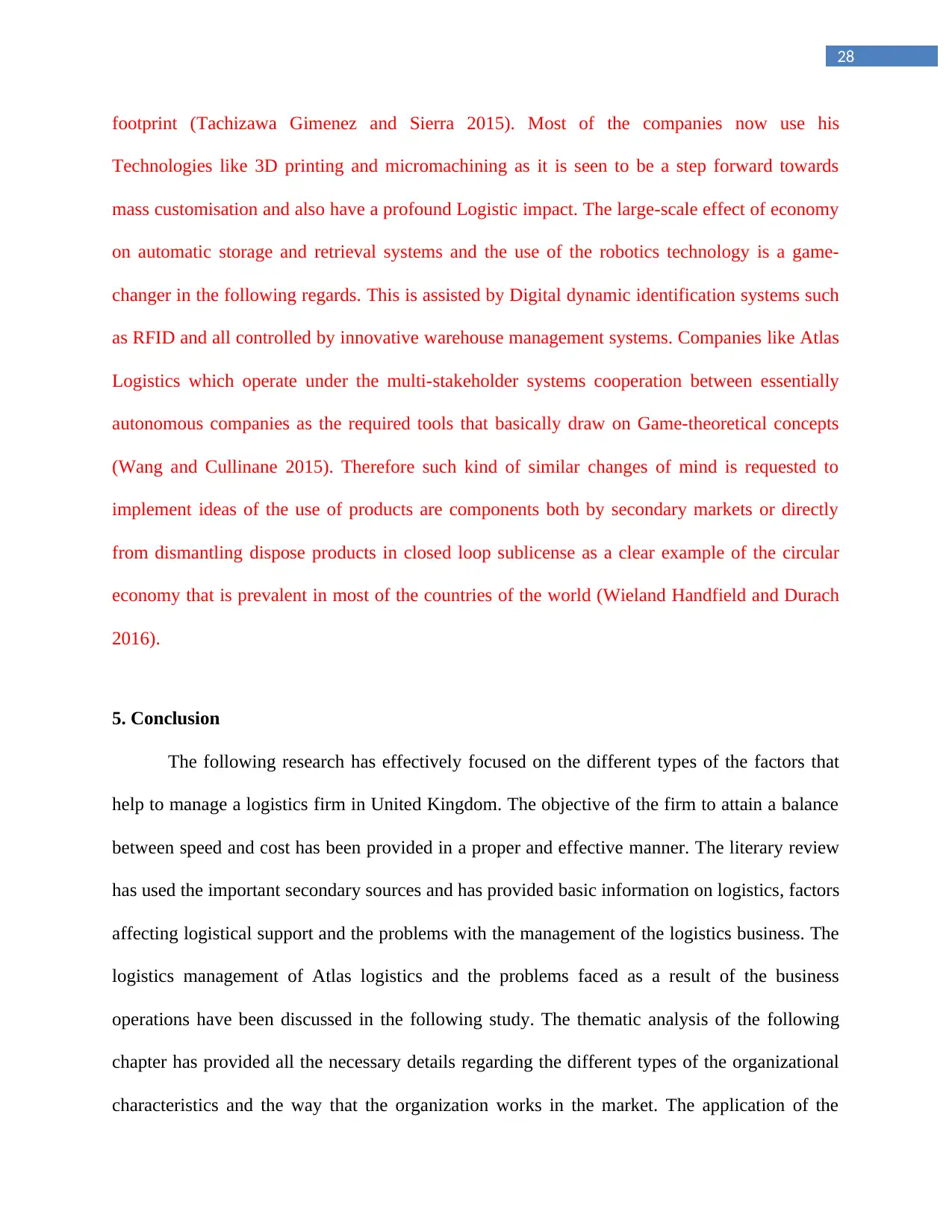
28
footprint (Tachizawa Gimenez and Sierra 2015). Most of the companies now use his
Technologies like 3D printing and micromachining as it is seen to be a step forward towards
mass customisation and also have a profound Logistic impact. The large-scale effect of economy
on automatic storage and retrieval systems and the use of the robotics technology is a game-
changer in the following regards. This is assisted by Digital dynamic identification systems such
as RFID and all controlled by innovative warehouse management systems. Companies like Atlas
Logistics which operate under the multi-stakeholder systems cooperation between essentially
autonomous companies as the required tools that basically draw on Game-theoretical concepts
(Wang and Cullinane 2015). Therefore such kind of similar changes of mind is requested to
implement ideas of the use of products are components both by secondary markets or directly
from dismantling dispose products in closed loop sublicense as a clear example of the circular
economy that is prevalent in most of the countries of the world (Wieland Handfield and Durach
2016).
5. Conclusion
The following research has effectively focused on the different types of the factors that
help to manage a logistics firm in United Kingdom. The objective of the firm to attain a balance
between speed and cost has been provided in a proper and effective manner. The literary review
has used the important secondary sources and has provided basic information on logistics, factors
affecting logistical support and the problems with the management of the logistics business. The
logistics management of Atlas logistics and the problems faced as a result of the business
operations have been discussed in the following study. The thematic analysis of the following
chapter has provided all the necessary details regarding the different types of the organizational
characteristics and the way that the organization works in the market. The application of the
footprint (Tachizawa Gimenez and Sierra 2015). Most of the companies now use his
Technologies like 3D printing and micromachining as it is seen to be a step forward towards
mass customisation and also have a profound Logistic impact. The large-scale effect of economy
on automatic storage and retrieval systems and the use of the robotics technology is a game-
changer in the following regards. This is assisted by Digital dynamic identification systems such
as RFID and all controlled by innovative warehouse management systems. Companies like Atlas
Logistics which operate under the multi-stakeholder systems cooperation between essentially
autonomous companies as the required tools that basically draw on Game-theoretical concepts
(Wang and Cullinane 2015). Therefore such kind of similar changes of mind is requested to
implement ideas of the use of products are components both by secondary markets or directly
from dismantling dispose products in closed loop sublicense as a clear example of the circular
economy that is prevalent in most of the countries of the world (Wieland Handfield and Durach
2016).
5. Conclusion
The following research has effectively focused on the different types of the factors that
help to manage a logistics firm in United Kingdom. The objective of the firm to attain a balance
between speed and cost has been provided in a proper and effective manner. The literary review
has used the important secondary sources and has provided basic information on logistics, factors
affecting logistical support and the problems with the management of the logistics business. The
logistics management of Atlas logistics and the problems faced as a result of the business
operations have been discussed in the following study. The thematic analysis of the following
chapter has provided all the necessary details regarding the different types of the organizational
characteristics and the way that the organization works in the market. The application of the
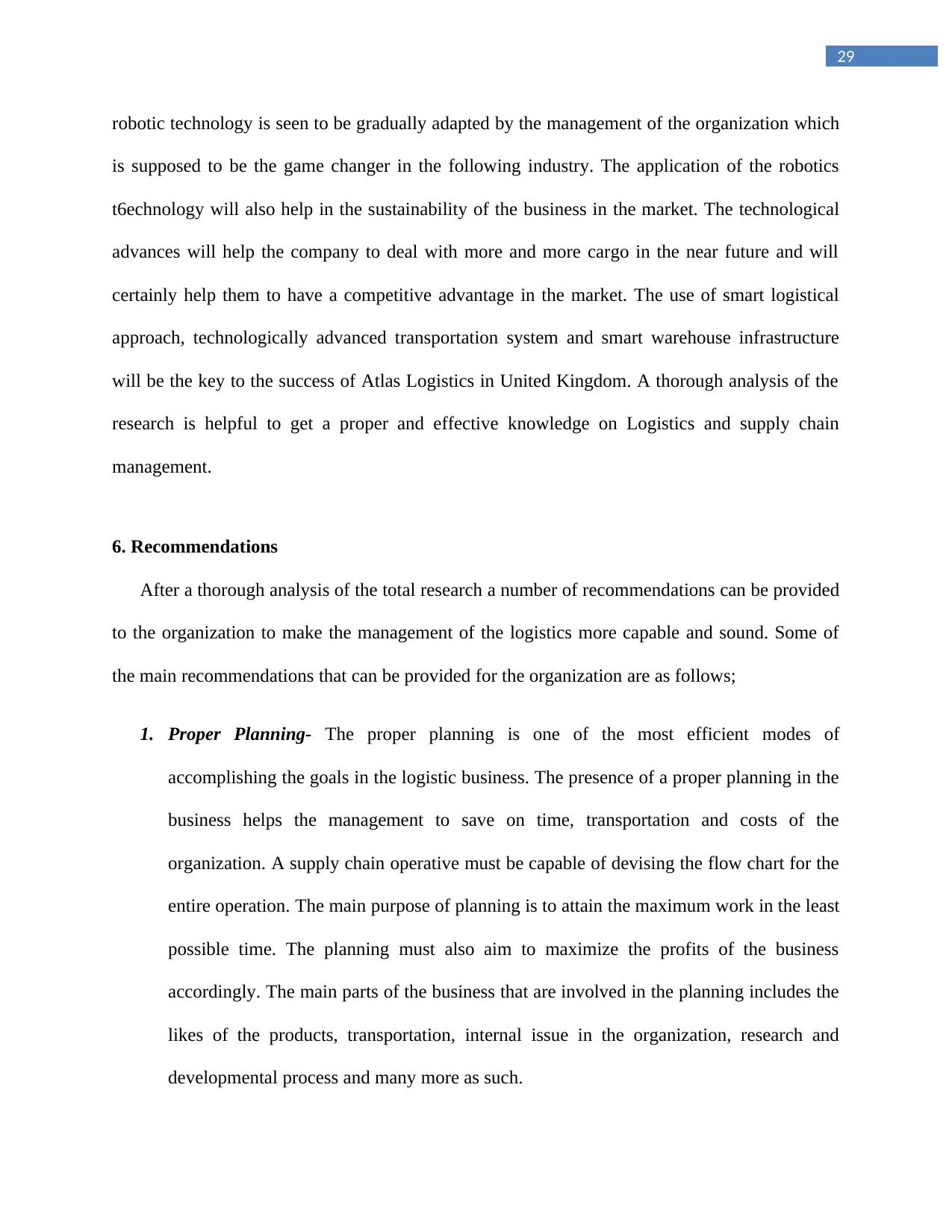
29
robotic technology is seen to be gradually adapted by the management of the organization which
is supposed to be the game changer in the following industry. The application of the robotics
t6echnology will also help in the sustainability of the business in the market. The technological
advances will help the company to deal with more and more cargo in the near future and will
certainly help them to have a competitive advantage in the market. The use of smart logistical
approach, technologically advanced transportation system and smart warehouse infrastructure
will be the key to the success of Atlas Logistics in United Kingdom. A thorough analysis of the
research is helpful to get a proper and effective knowledge on Logistics and supply chain
management.
6. Recommendations
After a thorough analysis of the total research a number of recommendations can be provided
to the organization to make the management of the logistics more capable and sound. Some of
the main recommendations that can be provided for the organization are as follows;
1. Proper Planning- The proper planning is one of the most efficient modes of
accomplishing the goals in the logistic business. The presence of a proper planning in the
business helps the management to save on time, transportation and costs of the
organization. A supply chain operative must be capable of devising the flow chart for the
entire operation. The main purpose of planning is to attain the maximum work in the least
possible time. The planning must also aim to maximize the profits of the business
accordingly. The main parts of the business that are involved in the planning includes the
likes of the products, transportation, internal issue in the organization, research and
developmental process and many more as such.
robotic technology is seen to be gradually adapted by the management of the organization which
is supposed to be the game changer in the following industry. The application of the robotics
t6echnology will also help in the sustainability of the business in the market. The technological
advances will help the company to deal with more and more cargo in the near future and will
certainly help them to have a competitive advantage in the market. The use of smart logistical
approach, technologically advanced transportation system and smart warehouse infrastructure
will be the key to the success of Atlas Logistics in United Kingdom. A thorough analysis of the
research is helpful to get a proper and effective knowledge on Logistics and supply chain
management.
6. Recommendations
After a thorough analysis of the total research a number of recommendations can be provided
to the organization to make the management of the logistics more capable and sound. Some of
the main recommendations that can be provided for the organization are as follows;
1. Proper Planning- The proper planning is one of the most efficient modes of
accomplishing the goals in the logistic business. The presence of a proper planning in the
business helps the management to save on time, transportation and costs of the
organization. A supply chain operative must be capable of devising the flow chart for the
entire operation. The main purpose of planning is to attain the maximum work in the least
possible time. The planning must also aim to maximize the profits of the business
accordingly. The main parts of the business that are involved in the planning includes the
likes of the products, transportation, internal issue in the organization, research and
developmental process and many more as such.

30
2. Automation adaption- The adoption of automatic procedures is important for the
business as because it helps the organization to improve its productivity by increasing the
efficiency of the company. The integration and the implementation of the business
process software is utmost necessary for the business to provide timely updates regarding
the dispatched goods, delivery and procurement of the different goods and many more as
such.
3. Value relations- The formation of a team and its bonding is an essential part to the
success of the organization. The team is generally an essential aspect of the organization
and it symbolizes the value that the relations has in the success of the organization.
4. Management of warehouse- The warehouse management is an effective way to ensure
success as because warehouse helps in the development of a great form of supply chain
that is essential for quality business. A better warehouse management will help the
management of the organization to dispatch perishable goods in an intact condition.
5. Efficient Mode of Transportation- As mentioned earlier, transportation is perhaps the
most important consideration in the success of the logistics business. The better the
transportation, the better will be the success of the logistics company in the market. The
presence of different types of trucks varying from large to small and the presence of
special purpose trucks are essential to a company dealing in logistics.
The above mentioned recommendations thus provide a clear insight in the techniques and
processes that can be adapted by the management of the company to gain tremendous success in
the market of United Kingdom.
2. Automation adaption- The adoption of automatic procedures is important for the
business as because it helps the organization to improve its productivity by increasing the
efficiency of the company. The integration and the implementation of the business
process software is utmost necessary for the business to provide timely updates regarding
the dispatched goods, delivery and procurement of the different goods and many more as
such.
3. Value relations- The formation of a team and its bonding is an essential part to the
success of the organization. The team is generally an essential aspect of the organization
and it symbolizes the value that the relations has in the success of the organization.
4. Management of warehouse- The warehouse management is an effective way to ensure
success as because warehouse helps in the development of a great form of supply chain
that is essential for quality business. A better warehouse management will help the
management of the organization to dispatch perishable goods in an intact condition.
5. Efficient Mode of Transportation- As mentioned earlier, transportation is perhaps the
most important consideration in the success of the logistics business. The better the
transportation, the better will be the success of the logistics company in the market. The
presence of different types of trucks varying from large to small and the presence of
special purpose trucks are essential to a company dealing in logistics.
The above mentioned recommendations thus provide a clear insight in the techniques and
processes that can be adapted by the management of the company to gain tremendous success in
the market of United Kingdom.
Paraphrase This Document
Need a fresh take? Get an instant paraphrase of this document with our AI Paraphraser
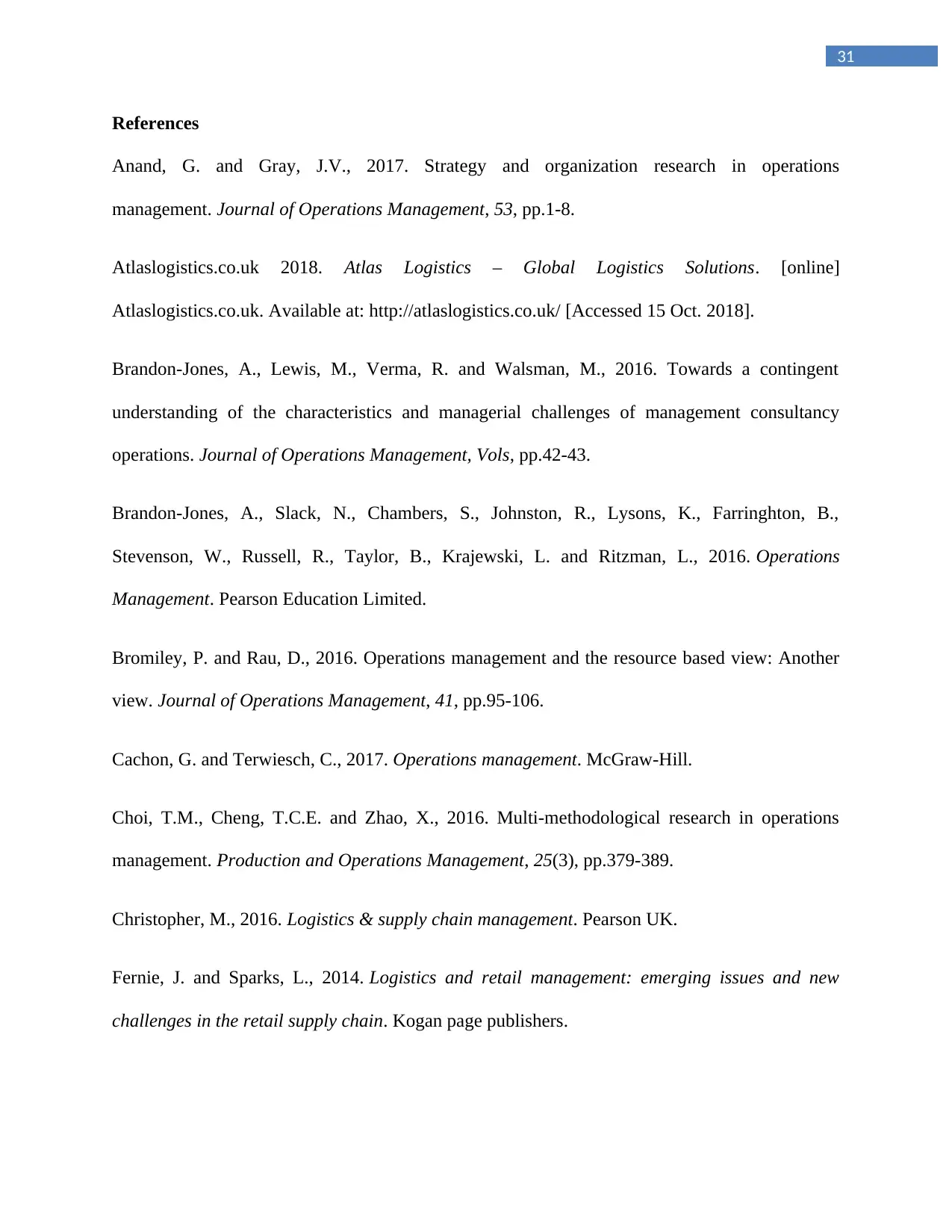
31
References
Anand, G. and Gray, J.V., 2017. Strategy and organization research in operations
management. Journal of Operations Management, 53, pp.1-8.
Atlaslogistics.co.uk 2018. Atlas Logistics – Global Logistics Solutions. [online]
Atlaslogistics.co.uk. Available at: http://atlaslogistics.co.uk/ [Accessed 15 Oct. 2018].
Brandon-Jones, A., Lewis, M., Verma, R. and Walsman, M., 2016. Towards a contingent
understanding of the characteristics and managerial challenges of management consultancy
operations. Journal of Operations Management, Vols, pp.42-43.
Brandon-Jones, A., Slack, N., Chambers, S., Johnston, R., Lysons, K., Farringhton, B.,
Stevenson, W., Russell, R., Taylor, B., Krajewski, L. and Ritzman, L., 2016. Operations
Management. Pearson Education Limited.
Bromiley, P. and Rau, D., 2016. Operations management and the resource based view: Another
view. Journal of Operations Management, 41, pp.95-106.
Cachon, G. and Terwiesch, C., 2017. Operations management. McGraw-Hill.
Choi, T.M., Cheng, T.C.E. and Zhao, X., 2016. Multi‐methodological research in operations
management. Production and Operations Management, 25(3), pp.379-389.
Christopher, M., 2016. Logistics & supply chain management. Pearson UK.
Fernie, J. and Sparks, L., 2014. Logistics and retail management: emerging issues and new
challenges in the retail supply chain. Kogan page publishers.
References
Anand, G. and Gray, J.V., 2017. Strategy and organization research in operations
management. Journal of Operations Management, 53, pp.1-8.
Atlaslogistics.co.uk 2018. Atlas Logistics – Global Logistics Solutions. [online]
Atlaslogistics.co.uk. Available at: http://atlaslogistics.co.uk/ [Accessed 15 Oct. 2018].
Brandon-Jones, A., Lewis, M., Verma, R. and Walsman, M., 2016. Towards a contingent
understanding of the characteristics and managerial challenges of management consultancy
operations. Journal of Operations Management, Vols, pp.42-43.
Brandon-Jones, A., Slack, N., Chambers, S., Johnston, R., Lysons, K., Farringhton, B.,
Stevenson, W., Russell, R., Taylor, B., Krajewski, L. and Ritzman, L., 2016. Operations
Management. Pearson Education Limited.
Bromiley, P. and Rau, D., 2016. Operations management and the resource based view: Another
view. Journal of Operations Management, 41, pp.95-106.
Cachon, G. and Terwiesch, C., 2017. Operations management. McGraw-Hill.
Choi, T.M., Cheng, T.C.E. and Zhao, X., 2016. Multi‐methodological research in operations
management. Production and Operations Management, 25(3), pp.379-389.
Christopher, M., 2016. Logistics & supply chain management. Pearson UK.
Fernie, J. and Sparks, L., 2014. Logistics and retail management: emerging issues and new
challenges in the retail supply chain. Kogan page publishers.

32
Flick, U., 2015. Introducing research methodology: A beginner's guide to doing a research
project. Sage.
Genovese, A., Acquaye, A.A., Figueroa, A. and Koh, S.L., 2017. Sustainable supply chain
management and the transition towards a circular economy: Evidence and some
applications. Omega, 66, pp.344-357.
Haksever, C. and Render, B., 2018. Service and Operations Management. World Scientific
Books.
Harvey, J., Heineke, J. and Lewis, M., 2016. Editorial for Journal of Operations Management
special issue on" Professional Service Operations Management (PSOM)". Journal of Operations
Management, 42, pp.4-8.
Heizer, J., Render, B., Munson, C. and Sachan, A., 2017. Operations management: sustainability
and supply chain management, 12/e.
Hitt, M. and Duane Ireland, R., 2017. The intersection of entrepreneurship and strategic
management research. The Blackwell guide to entrepreneurship, pp.45-63.
Hitt, M.A., Xu, K. and Carnes, C.M., 2016. Resource based theory in operations management
research. Journal of Operations Management, 41, pp.77-94.
Holweg, M., Davies, J., De Meyer, A. and Schmenner, R., 2018. Process Theory: The Principles
of Operations Management. Oxford University Press.
Jacobs, F.R. and Chase, R.B., 2017. Operation and supply chain management. Mc GrawHill.
Flick, U., 2015. Introducing research methodology: A beginner's guide to doing a research
project. Sage.
Genovese, A., Acquaye, A.A., Figueroa, A. and Koh, S.L., 2017. Sustainable supply chain
management and the transition towards a circular economy: Evidence and some
applications. Omega, 66, pp.344-357.
Haksever, C. and Render, B., 2018. Service and Operations Management. World Scientific
Books.
Harvey, J., Heineke, J. and Lewis, M., 2016. Editorial for Journal of Operations Management
special issue on" Professional Service Operations Management (PSOM)". Journal of Operations
Management, 42, pp.4-8.
Heizer, J., Render, B., Munson, C. and Sachan, A., 2017. Operations management: sustainability
and supply chain management, 12/e.
Hitt, M. and Duane Ireland, R., 2017. The intersection of entrepreneurship and strategic
management research. The Blackwell guide to entrepreneurship, pp.45-63.
Hitt, M.A., Xu, K. and Carnes, C.M., 2016. Resource based theory in operations management
research. Journal of Operations Management, 41, pp.77-94.
Holweg, M., Davies, J., De Meyer, A. and Schmenner, R., 2018. Process Theory: The Principles
of Operations Management. Oxford University Press.
Jacobs, F.R. and Chase, R.B., 2017. Operation and supply chain management. Mc GrawHill.
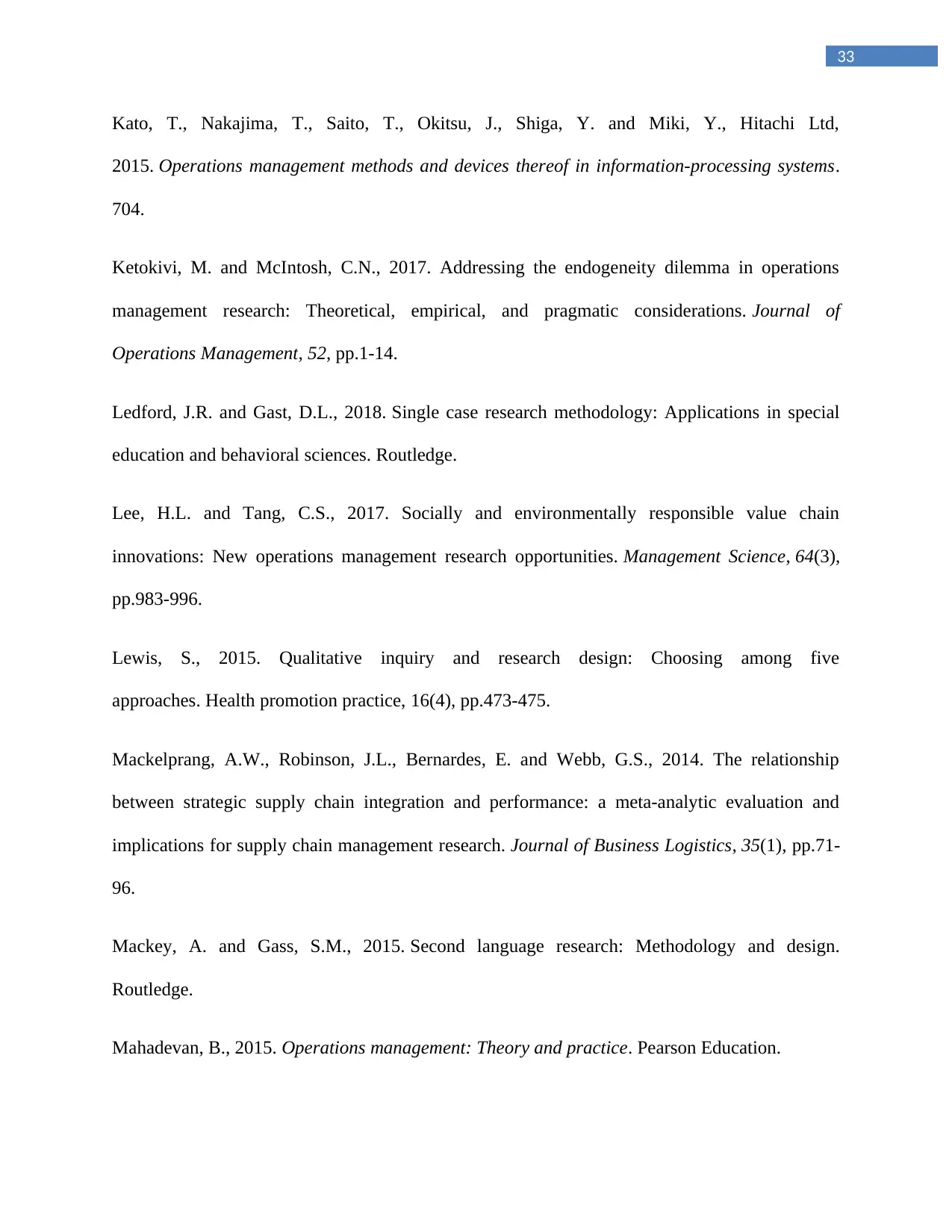
33
Kato, T., Nakajima, T., Saito, T., Okitsu, J., Shiga, Y. and Miki, Y., Hitachi Ltd,
2015. Operations management methods and devices thereof in information-processing systems.
704.
Ketokivi, M. and McIntosh, C.N., 2017. Addressing the endogeneity dilemma in operations
management research: Theoretical, empirical, and pragmatic considerations. Journal of
Operations Management, 52, pp.1-14.
Ledford, J.R. and Gast, D.L., 2018. Single case research methodology: Applications in special
education and behavioral sciences. Routledge.
Lee, H.L. and Tang, C.S., 2017. Socially and environmentally responsible value chain
innovations: New operations management research opportunities. Management Science, 64(3),
pp.983-996.
Lewis, S., 2015. Qualitative inquiry and research design: Choosing among five
approaches. Health promotion practice, 16(4), pp.473-475.
Mackelprang, A.W., Robinson, J.L., Bernardes, E. and Webb, G.S., 2014. The relationship
between strategic supply chain integration and performance: a meta‐analytic evaluation and
implications for supply chain management research. Journal of Business Logistics, 35(1), pp.71-
96.
Mackey, A. and Gass, S.M., 2015. Second language research: Methodology and design.
Routledge.
Mahadevan, B., 2015. Operations management: Theory and practice. Pearson Education.
Kato, T., Nakajima, T., Saito, T., Okitsu, J., Shiga, Y. and Miki, Y., Hitachi Ltd,
2015. Operations management methods and devices thereof in information-processing systems.
704.
Ketokivi, M. and McIntosh, C.N., 2017. Addressing the endogeneity dilemma in operations
management research: Theoretical, empirical, and pragmatic considerations. Journal of
Operations Management, 52, pp.1-14.
Ledford, J.R. and Gast, D.L., 2018. Single case research methodology: Applications in special
education and behavioral sciences. Routledge.
Lee, H.L. and Tang, C.S., 2017. Socially and environmentally responsible value chain
innovations: New operations management research opportunities. Management Science, 64(3),
pp.983-996.
Lewis, S., 2015. Qualitative inquiry and research design: Choosing among five
approaches. Health promotion practice, 16(4), pp.473-475.
Mackelprang, A.W., Robinson, J.L., Bernardes, E. and Webb, G.S., 2014. The relationship
between strategic supply chain integration and performance: a meta‐analytic evaluation and
implications for supply chain management research. Journal of Business Logistics, 35(1), pp.71-
96.
Mackey, A. and Gass, S.M., 2015. Second language research: Methodology and design.
Routledge.
Mahadevan, B., 2015. Operations management: Theory and practice. Pearson Education.
Secure Best Marks with AI Grader
Need help grading? Try our AI Grader for instant feedback on your assignments.
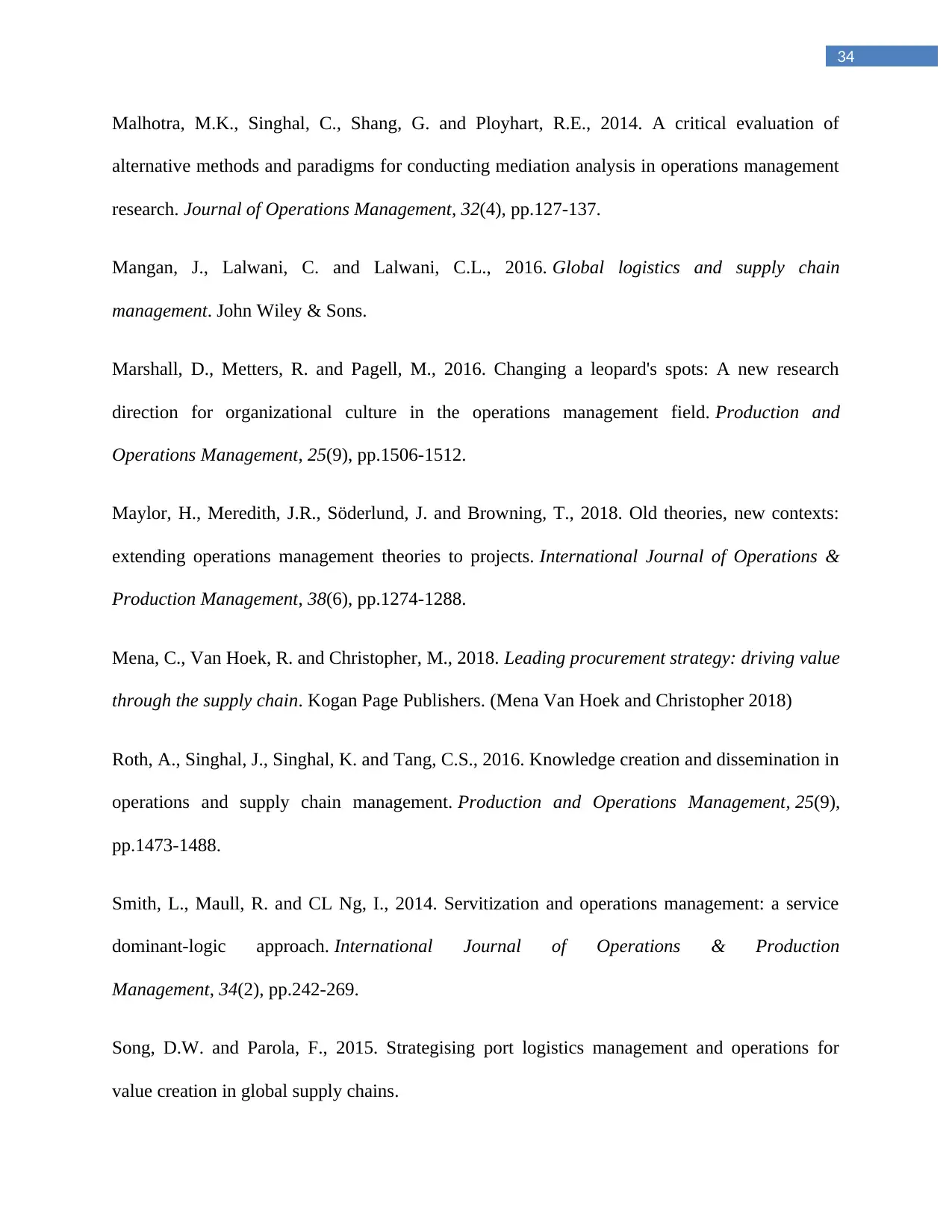
34
Malhotra, M.K., Singhal, C., Shang, G. and Ployhart, R.E., 2014. A critical evaluation of
alternative methods and paradigms for conducting mediation analysis in operations management
research. Journal of Operations Management, 32(4), pp.127-137.
Mangan, J., Lalwani, C. and Lalwani, C.L., 2016. Global logistics and supply chain
management. John Wiley & Sons.
Marshall, D., Metters, R. and Pagell, M., 2016. Changing a leopard's spots: A new research
direction for organizational culture in the operations management field. Production and
Operations Management, 25(9), pp.1506-1512.
Maylor, H., Meredith, J.R., Söderlund, J. and Browning, T., 2018. Old theories, new contexts:
extending operations management theories to projects. International Journal of Operations &
Production Management, 38(6), pp.1274-1288.
Mena, C., Van Hoek, R. and Christopher, M., 2018. Leading procurement strategy: driving value
through the supply chain. Kogan Page Publishers. (Mena Van Hoek and Christopher 2018)
Roth, A., Singhal, J., Singhal, K. and Tang, C.S., 2016. Knowledge creation and dissemination in
operations and supply chain management. Production and Operations Management, 25(9),
pp.1473-1488.
Smith, L., Maull, R. and CL Ng, I., 2014. Servitization and operations management: a service
dominant-logic approach. International Journal of Operations & Production
Management, 34(2), pp.242-269.
Song, D.W. and Parola, F., 2015. Strategising port logistics management and operations for
value creation in global supply chains.
Malhotra, M.K., Singhal, C., Shang, G. and Ployhart, R.E., 2014. A critical evaluation of
alternative methods and paradigms for conducting mediation analysis in operations management
research. Journal of Operations Management, 32(4), pp.127-137.
Mangan, J., Lalwani, C. and Lalwani, C.L., 2016. Global logistics and supply chain
management. John Wiley & Sons.
Marshall, D., Metters, R. and Pagell, M., 2016. Changing a leopard's spots: A new research
direction for organizational culture in the operations management field. Production and
Operations Management, 25(9), pp.1506-1512.
Maylor, H., Meredith, J.R., Söderlund, J. and Browning, T., 2018. Old theories, new contexts:
extending operations management theories to projects. International Journal of Operations &
Production Management, 38(6), pp.1274-1288.
Mena, C., Van Hoek, R. and Christopher, M., 2018. Leading procurement strategy: driving value
through the supply chain. Kogan Page Publishers. (Mena Van Hoek and Christopher 2018)
Roth, A., Singhal, J., Singhal, K. and Tang, C.S., 2016. Knowledge creation and dissemination in
operations and supply chain management. Production and Operations Management, 25(9),
pp.1473-1488.
Smith, L., Maull, R. and CL Ng, I., 2014. Servitization and operations management: a service
dominant-logic approach. International Journal of Operations & Production
Management, 34(2), pp.242-269.
Song, D.W. and Parola, F., 2015. Strategising port logistics management and operations for
value creation in global supply chains.
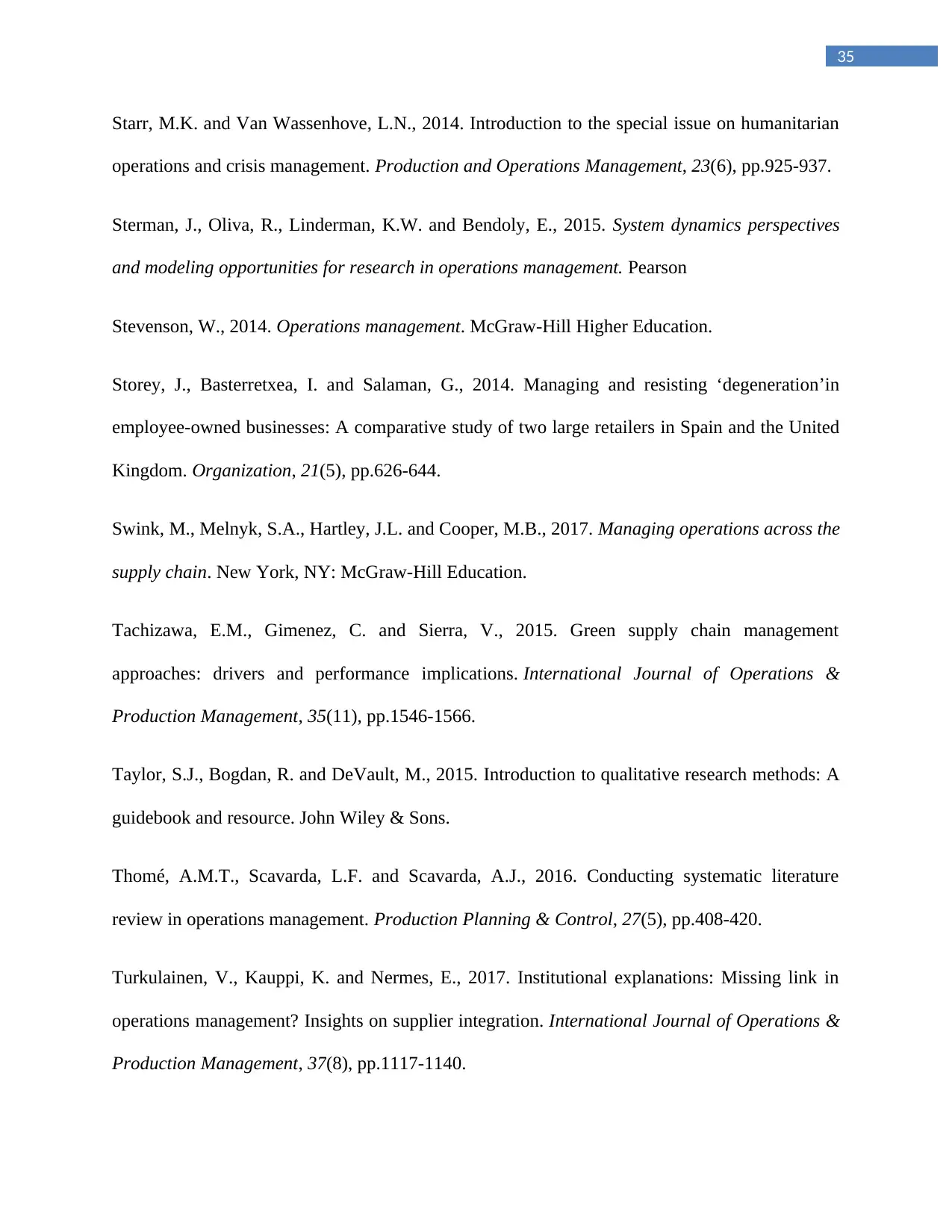
35
Starr, M.K. and Van Wassenhove, L.N., 2014. Introduction to the special issue on humanitarian
operations and crisis management. Production and Operations Management, 23(6), pp.925-937.
Sterman, J., Oliva, R., Linderman, K.W. and Bendoly, E., 2015. System dynamics perspectives
and modeling opportunities for research in operations management. Pearson
Stevenson, W., 2014. Operations management. McGraw-Hill Higher Education.
Storey, J., Basterretxea, I. and Salaman, G., 2014. Managing and resisting ‘degeneration’in
employee-owned businesses: A comparative study of two large retailers in Spain and the United
Kingdom. Organization, 21(5), pp.626-644.
Swink, M., Melnyk, S.A., Hartley, J.L. and Cooper, M.B., 2017. Managing operations across the
supply chain. New York, NY: McGraw-Hill Education.
Tachizawa, E.M., Gimenez, C. and Sierra, V., 2015. Green supply chain management
approaches: drivers and performance implications. International Journal of Operations &
Production Management, 35(11), pp.1546-1566.
Taylor, S.J., Bogdan, R. and DeVault, M., 2015. Introduction to qualitative research methods: A
guidebook and resource. John Wiley & Sons.
Thomé, A.M.T., Scavarda, L.F. and Scavarda, A.J., 2016. Conducting systematic literature
review in operations management. Production Planning & Control, 27(5), pp.408-420.
Turkulainen, V., Kauppi, K. and Nermes, E., 2017. Institutional explanations: Missing link in
operations management? Insights on supplier integration. International Journal of Operations &
Production Management, 37(8), pp.1117-1140.
Starr, M.K. and Van Wassenhove, L.N., 2014. Introduction to the special issue on humanitarian
operations and crisis management. Production and Operations Management, 23(6), pp.925-937.
Sterman, J., Oliva, R., Linderman, K.W. and Bendoly, E., 2015. System dynamics perspectives
and modeling opportunities for research in operations management. Pearson
Stevenson, W., 2014. Operations management. McGraw-Hill Higher Education.
Storey, J., Basterretxea, I. and Salaman, G., 2014. Managing and resisting ‘degeneration’in
employee-owned businesses: A comparative study of two large retailers in Spain and the United
Kingdom. Organization, 21(5), pp.626-644.
Swink, M., Melnyk, S.A., Hartley, J.L. and Cooper, M.B., 2017. Managing operations across the
supply chain. New York, NY: McGraw-Hill Education.
Tachizawa, E.M., Gimenez, C. and Sierra, V., 2015. Green supply chain management
approaches: drivers and performance implications. International Journal of Operations &
Production Management, 35(11), pp.1546-1566.
Taylor, S.J., Bogdan, R. and DeVault, M., 2015. Introduction to qualitative research methods: A
guidebook and resource. John Wiley & Sons.
Thomé, A.M.T., Scavarda, L.F. and Scavarda, A.J., 2016. Conducting systematic literature
review in operations management. Production Planning & Control, 27(5), pp.408-420.
Turkulainen, V., Kauppi, K. and Nermes, E., 2017. Institutional explanations: Missing link in
operations management? Insights on supplier integration. International Journal of Operations &
Production Management, 37(8), pp.1117-1140.

36
van Aken, J., Chandrasekaran, A. and Halman, J., 2016. Conducting and publishing design
science research: Inaugural essay of the design science department of the Journal of Operations
Management. Journal of operations management, 47, pp.1-8.
Walker, H., Chicksand, D., Radnor, Z. and Watson, G., 2015. Theoretical perspectives in
operations management: an analysis of the literature. International Journal of Operations &
Production Management, 35(8), pp.1182-1206.
Wang, T. and Cullinane, K., 2015. The efficiency of European container terminals and
implications for supply chain management. In Port management (pp. 253-272). Palgrave
Macmillan, London.
Wieland, A., Handfield, R.B. and Durach, C.F., 2016. Mapping the landscape of future research
themes in supply chain management. Journal of Business Logistics, 37(3), pp.205-212.
van Aken, J., Chandrasekaran, A. and Halman, J., 2016. Conducting and publishing design
science research: Inaugural essay of the design science department of the Journal of Operations
Management. Journal of operations management, 47, pp.1-8.
Walker, H., Chicksand, D., Radnor, Z. and Watson, G., 2015. Theoretical perspectives in
operations management: an analysis of the literature. International Journal of Operations &
Production Management, 35(8), pp.1182-1206.
Wang, T. and Cullinane, K., 2015. The efficiency of European container terminals and
implications for supply chain management. In Port management (pp. 253-272). Palgrave
Macmillan, London.
Wieland, A., Handfield, R.B. and Durach, C.F., 2016. Mapping the landscape of future research
themes in supply chain management. Journal of Business Logistics, 37(3), pp.205-212.
1 out of 37
Related Documents
Your All-in-One AI-Powered Toolkit for Academic Success.
+13062052269
info@desklib.com
Available 24*7 on WhatsApp / Email
![[object Object]](/_next/static/media/star-bottom.7253800d.svg)
Unlock your academic potential
© 2024 | Zucol Services PVT LTD | All rights reserved.





